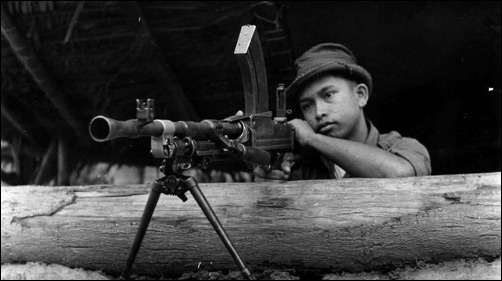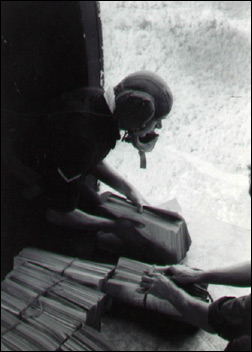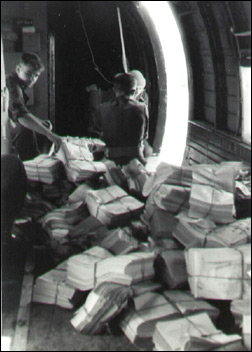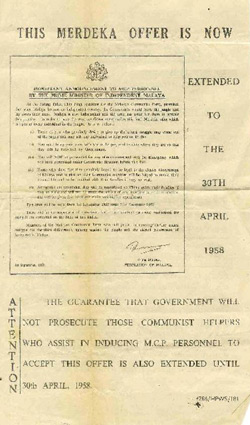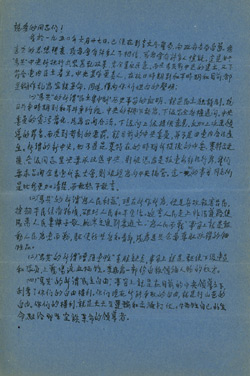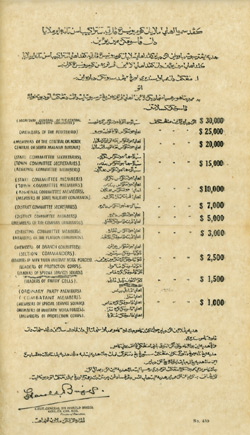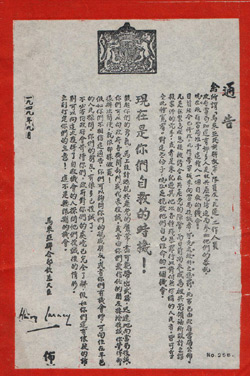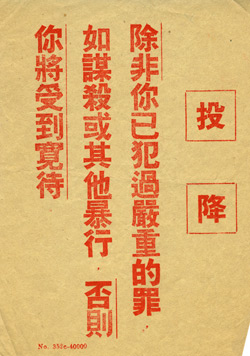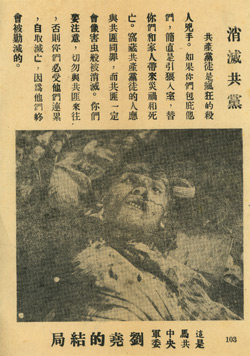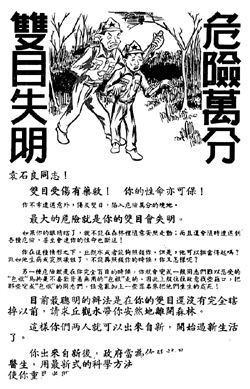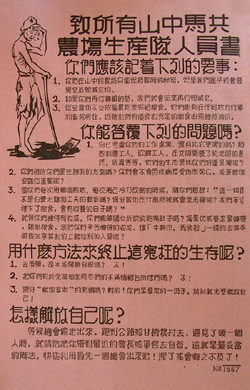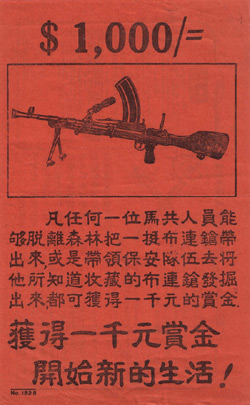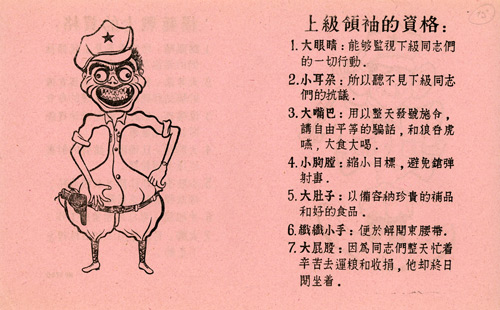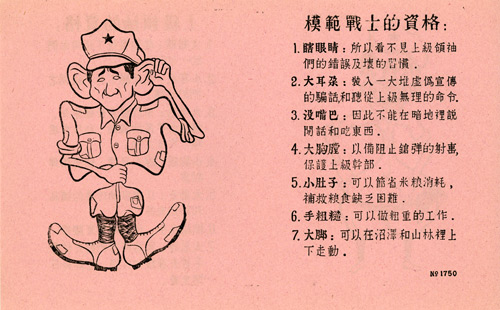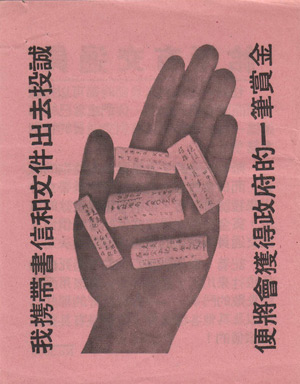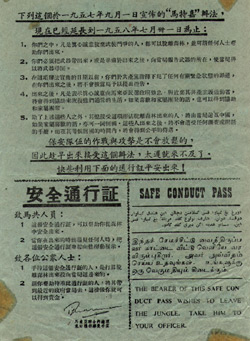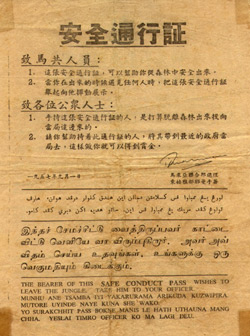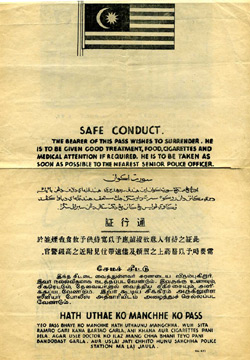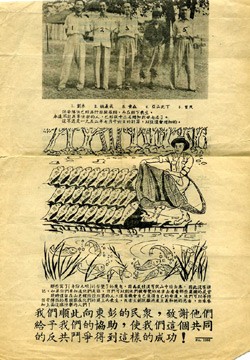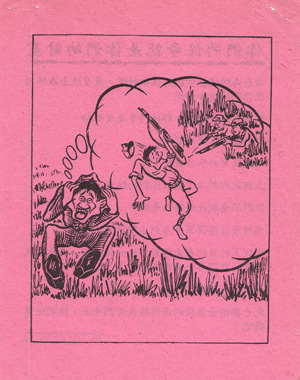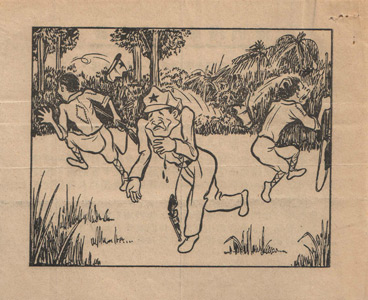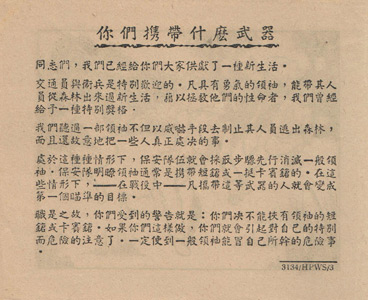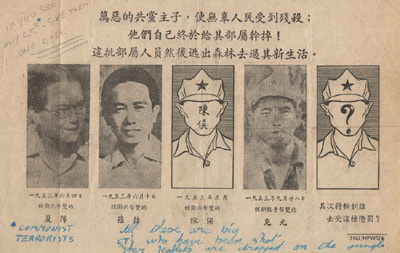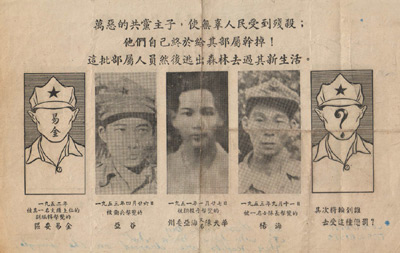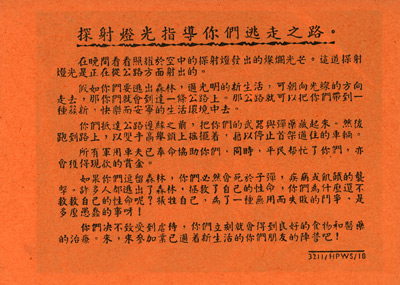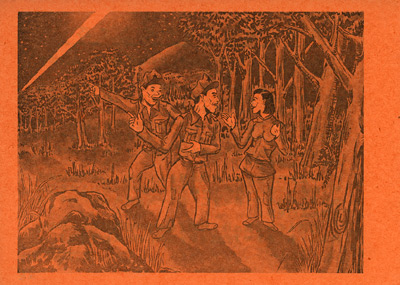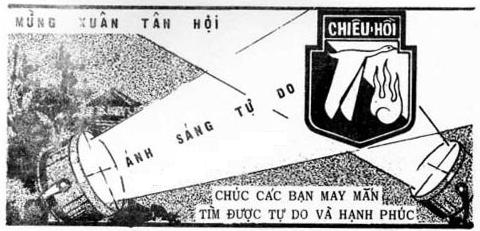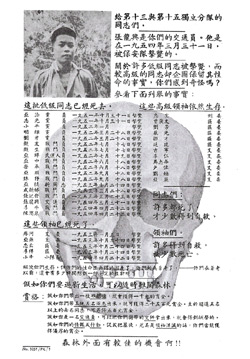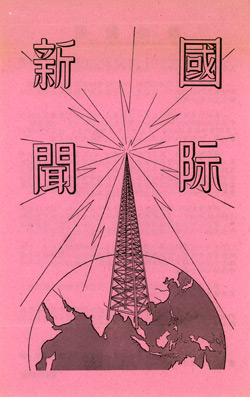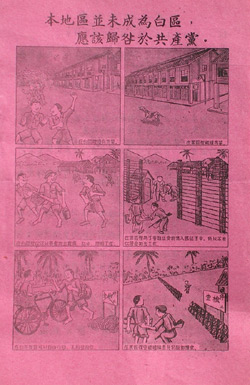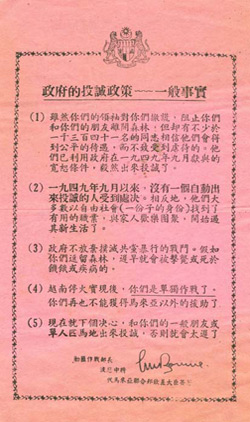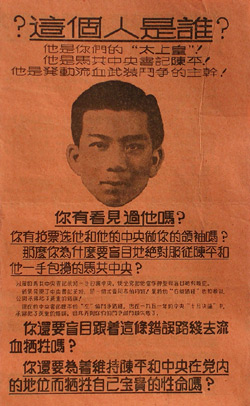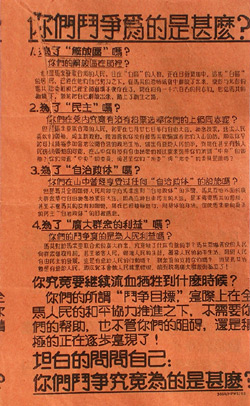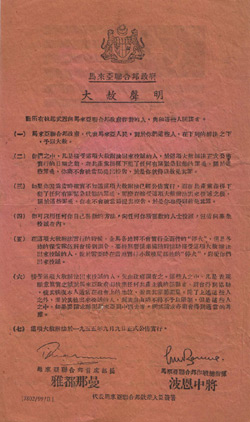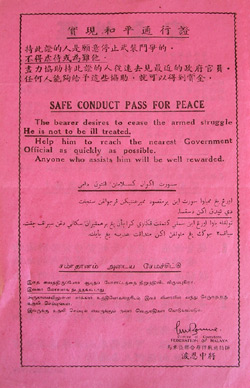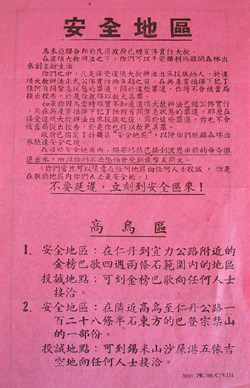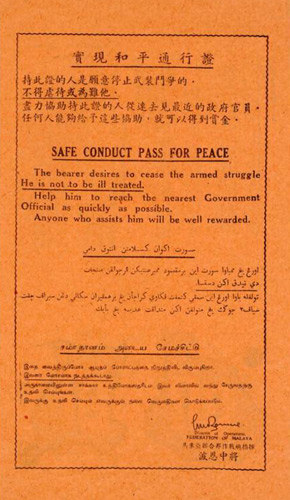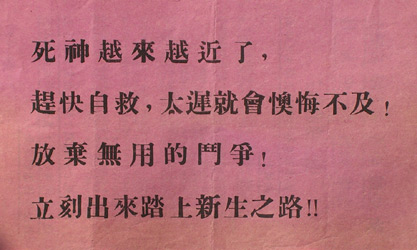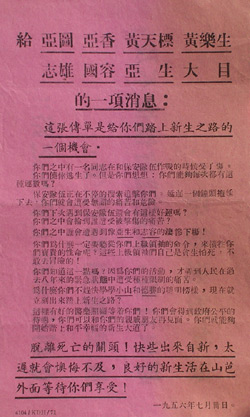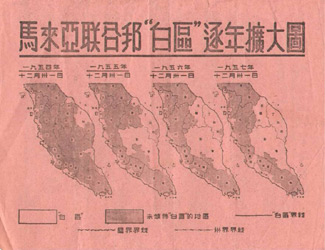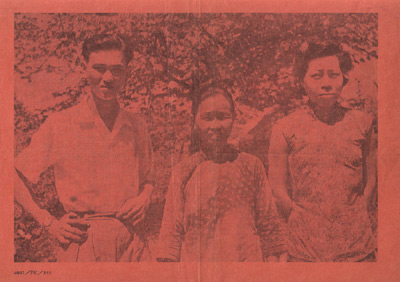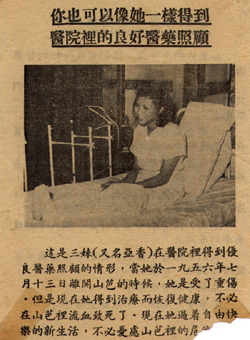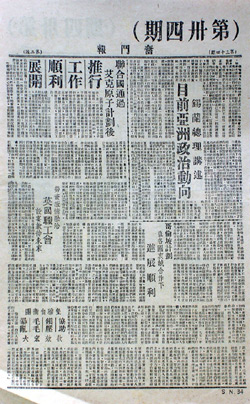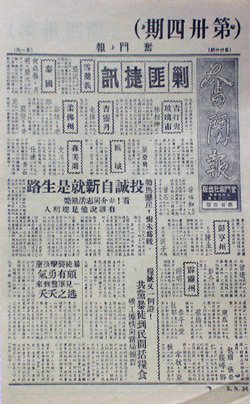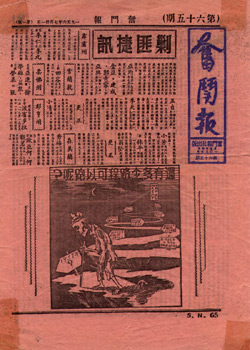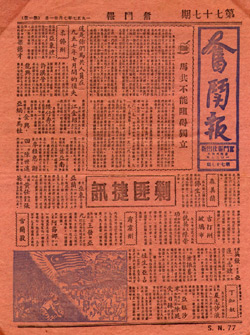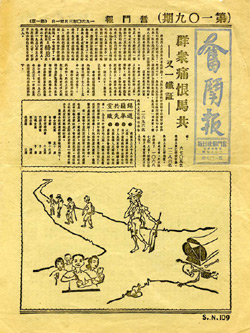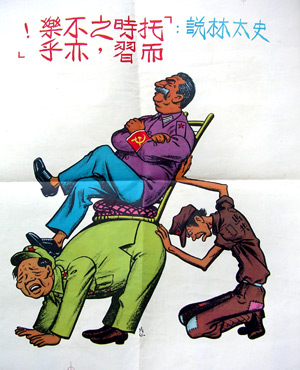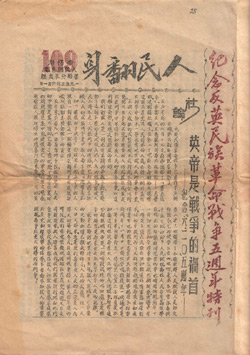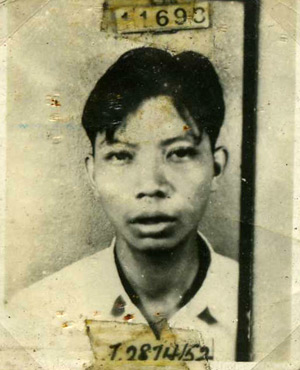Forty years ago when we were studying what was then called 'Guerrilla Warfare,' the Army taught us that there were just three successful cases where a legitimate government in power had beaten back a Communist insurgency. They were the Philippines, Greece, and Malaya. I can still remember a Colonel explaining that in the Philippines the victory against the HUKs was won by land reform, in Greece by tightening the borders and not allowing the guerrillas to slip into Albania for refuge and resupply, and in Malaya by separating the insurgents from the general population and letting them starve in the jungle. Since that time, there have been dozens of insurgencies, some successful, some not.
I study American Psychological Operations and do not claim to be an authority on British PSYOP in Malaya. However, PsyWar specialist
Lee Richards obtained copies of a number of propaganda leaflets dropped on the Malayan guerrillas and asked me to put something together in the way of a narration. The following is my attempt to tell the story of PSYOP during the Malayan campaign. If any reader cares to add to this story with personal narrations, additional leaflets or translations, they are more than welcome to do so. Although I have used a number of different sources for this brief report,
The Malayan Emergency: an Example of a Successful Counter-Insurgency Campaign, by Major Zolkopli bin Hashim of the Malaysian Army is my main reference source. I have used a number of reference papers as secondary sources, since they quite often are filled with statistics that are not found in regular studies. Among them is R. W. Komer's Rand Advanced Research Project study "The Malayan Emergency in Retrospect: Organization of a Successful Counterinsurgency Effort, and James A. Bortree's Naval Postgraduate School thesis "Information Operations during the Malayan Emergency."
It appears that the British also ran a very sophisticated clandestine propaganda campaign in Malaya and went so far as to establish a regional office of their top secret Information Research Department (IRD) in Singapore in 1949. Paul Lashmar and James Oliver say in Britain's Secret Propaganda War 1948-1977, Sutton Publishing, UK, 1998:
In this early period, the IRD's role was not limited to persuading the public, but often included in convincing other parts of the British government to take the Communist threat seriously… By 1950, events and the IRD had had apparently succeeded and the Colonial Office was eager to perceive the Malayan Communist party as part of the Kremlin’s world-wide campaign against the Western powers… Not least to insure the support of the United States, it became essential that challenges to British colonial rule should be understood within the framework – that of a substantial Soviet and Communist threat…the Empire was to be given a shot in the arm rather than a shot in the head….
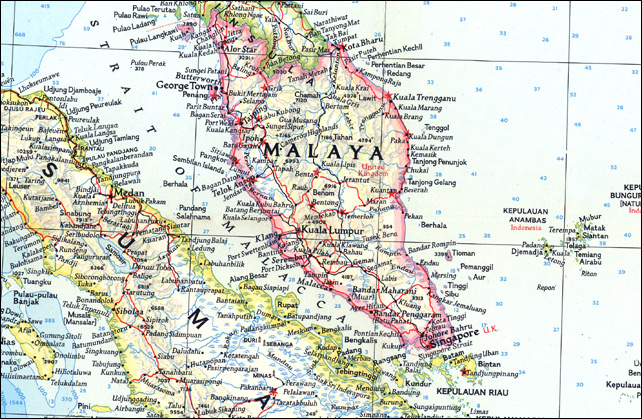
Because of the perceived success of the British Malayan counterinsurgency campaign, the United States Department of Defense asked theRand Corporation to prepare a study of the British methods. America was deep in the Vietnam quagmire at the moment. That project became the 1964 Winning the Hearts and Minds of the People: Malaya, 1948-1980 by Riley Sunderland. It was issued as the 57-pageMemorandum RM-4174-ISA. In fact, Rand published five such research memorandums on the Malayan Emergency, but this fifth study concerns the campaign of public information, civic action, and other persuasive measures. The study used classified British and American documents and interviews with participants of the campaign as reference material.
Much of what Sunderland says is mentioned in other segments of this article and will be quoted. In regard to the Civil Service he points out that the British were careful to get the best possible people that were flexible and would be able to adapt to the Communist insurgency:
The few hundred British subjects who served in the Malayan Civil Service were an elite group, so carefully chosen as to be known locally as "the heaven-born." It was clear that Britain had discarded the eighteenth-century notion that colonies and protectorates were meant to provide jobs for citizens of the mother country.
As a fairly successful colony, Malaya was wooed by both the Chinese Communists and Nationalists for many years before World War II. In general, the Malayan Chinese did their trading with little regard for politics. The British were strongly anti-Communist and the Chinese Communist Party (CCP) had little to offer the average Malayan. There was a Malayan Communist Party (MCP), but it was small with a negligible membership. This changed in 1937 when the Empire of Japan invaded the Chinese mainland. The Communists could now claim that they needed membership and funds to protect the homeland, and using theses such as 'the National Salvation Movement' and 'Save China' organizations, the MCP increased its membership from 1,000 to about 5,000. Japan then invaded Malaya in December 1941. The communists took to the jungle where they fought a guerrilla action against the Japanese as the Malayan People's Anti-Japanese Army (MPAJA) until 1945. This army became a well organized underground resistance force with regiments established in the various Malayan states. It was these troops that later formed the nucleus of the guerrilla movement during the insurgency. And, like the Vietnamese who would also fight for their freedom, the jungle warfare taught the communists how to survive in a hostile environment, and enabled them to establish contact with the population along the jungle fringes.
Just as the American OSS helped to train the Viet Minh, British Commando Force 136 helped to train and supply the communist guerrillas in Malaya. Like Mao in China, they plotted and planned to take power once the victorious Allies had beaten the Japanese. Upon the end of the war in August 1945, the guerrillas took retributive action against Japanese collaborators while enlisting the aid of Japanese soldiers who were expert in the making and designing of mines and booby-traps. The British returned to Malaya in September 1945 expecting business as usual. They would be surprised.
C. C. Too talks about this period between the defeat of the Japanese and the return of the British in an article entitled 'Defeating Communism in Malaya', Military Review, August 1967. He says in part:
During the period of the Japanese surrender, the Communists carried out 'mass trials' before the return of the Allied forces to the Malay Peninsula. Many alleged collaborators were executed during the mass trials which the local population was forced to attend. During a period of three to six months, the Communists were in complete control of the smaller towns and remote villages before the Allied forces completed the process of taking over.
One of the most attractive propaganda lines of the Communists was land reform which had already proved popular and extremely effective to the landless peasants in China, and the MCP was not slow in exploiting this line.
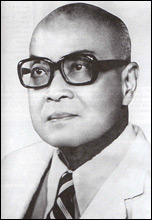 Too Chee Choo AKA C. C. Too
Too Chee Choo AKA C. C. TooEvery book written on the Malayan Emergency credits C. C. Too with being the mastermind behind the British psychological operations that destroyed the Communist insurgent movement. Probably the best biography of Too is The Story of a Psy-Warrior, Lim Cheng Leng, Malaysia, 2000. The author points out that Too was not recognized during the Emergency and it was many years afterwards that he finally received public recognition. The author describes him as a student:
A clear and fast thinker, with photographic memory, magnetic gaze and oratorical skills.
He met many Communist Party members as a scholarship student and President of the student body of Raffles College. He was regularly recruited to join them but declined. He said that the Communists were:
A gang of half-educated, swollen headed, power-mad adolescent demagogues trying to take over the country. I told them many facts which, as self-claimed leaders, they should have known but did not. What they were really trying to carry out boiled down to nothing but a gigantic swindle.
Born Too Chee Chew, he was nicknamed C. C. Too in 1945 by two American Office of Strategic Services (OSS) officers who had trouble remembering his full name. Shortly afterwards, he convinced a high-ranking Communist official to defect after a friendly evening discussion. It became clear that he had a natural expertise in psychological operations.
In early 1950 the Emergency Information Service was formed. Too joined the organization in February 1951. He initiated a study of the enemy's mentality and strategy. He asked to see every captured document. Since he understood the Communist Chinese terminology and phrasing he quickly became an expert, often correcting erroneous translations by civil servants and British officers. However, continued disagreements with the way the British used or ignored his information and fought the war caused him to resign in March 1953.
In Early 1955, O. W. Wolters was named head of the Psychological Warfare Section. He brought Too back into the fold in April 1955. By November 1956, Too was the head of the section. He soon become the leading authority and an expert in what he called "study and research." He wanted to know more about the Communists and their theories then they knew themselves. He could anticipate the actions of the Communists because he was able to think like them. He obtained this skill by analyzing and recording the Communist documents and directives that passed his desk. Lim Cheng Leng says:
C. C. Too's noted style was to borrow chapter and verse from the enemy's work program, which included sending in the "eyes and ears" to find out the likes and dislikes of the villagers; the problems and the things that bothered them. Such PSYOP reach-out varied from area to area and from place to place.
He knew that the Communists always sent an advance party in disguise into an area to discover local problems and prepare their campaign. He copied them and did exactly the same thing. He believed that it was more important to propagandize the people than the insurgents. The terrorists based their actions on the opinion of the populace so it was the latter that needed to be convinced. He thought that his most important weapons were the press, the radio, and leaflets and other media such as booklets and magazines. Terrorists may not believe the leaflets or the radio, but they would believe what they were told by the masses, so it was the people who should be swayed. He would convince the people by showing them that they were better off with the government than with a Communist dictatorship.
Too came up with several ideas that were novel at the time:
C. C. Too ingeniously developed the light yellow sand and the deep brown earth colors for leaflets to be thrown near streams and rivers to enable the comrade to steal a glance at them without undue attention.
When the British wanted to jam the Communist Chinese Radio Voice of Malayan Revolution (VOMR), Too argued that the operation would be expensive, and worse, counter-productive since analysis of the broadcasts would keep the government posted on the moves and future intentions of the Malayan Communist party. He wanted to know what they were thinking and saying.
He was sympathetic to the communist insurgent who had joined believing that he was fighting for a better world. He did not hate them or seek to track them down and kill them. He would address them by leaflet and radio and point out that international Communism was based on a lie and that they could help the people far more by returning to the government. He welcomed defectors, treated them well, and then used their testimony to convince their comrades to rejoin society.
In later years Too became a consultant to the US military, lecturing on Psychological Warfare and Counter-Insurgency at the U.S. Army Command and General Staff College, Ft. Leavenworth, Kansas on 15 October 1962. He also worked with the Republic of Korea and advised US forces during the Vietnam War. He was awarded the MBE (Member of the Most Distinguished Order of the British Empire) in January 1957. On 4 June 1986 he was awarded the Malaysian Panglima Setia Mahkota (Knight Commander of the Order of the Crown) and the honorary title Tan Sri.
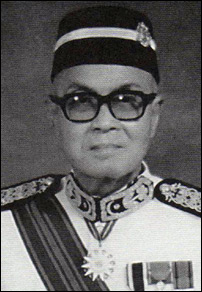
Since C. C. Too became the head of the Psychological Warfare Section of the Federation of Malaya, perhaps we should take a brief look at that unit and how it was organized and performed its mission. Too had seven subordinates responsible for the following operational sections: Leaflets and voice messages; leaflet dropping and loudspeaker aircraft; printing, packing and distribution; interrogation; translations; documentary research; and the consolidation of sorting, interrogations and translations.
The Psychological Warfare Section produced about 6 million leaflets each month. The printing was done by the official Government Printing agency or by eight local private printing firms approved by the agency, all in Kuala Lumpur. The Distribution Section packed the leaflets into bundles of 2,500 each at the Kuala Lumpur Royal Air Force Station. The loading of the aircraft was carried out by Air Dispatch Company 55, which also provided dispatchers (4 in a Valetta and 5 in a Bristol Freighter aircraft).
The recording of taped messages in all the languages and dialects of Malaya was undertaken by Radio Malaya who provided announcers and recording staff at their studio in Kuala Lumpur. Messages were recorded on a continuous plastic tape 19 feet long with a playing time of 30 seconds. The messages were broadcast by Dakota and Auster aircraft of the Voice Aircraft Flight of Royal Air Force Squadron 267.
With the return of the British, the MPAJA was disbanded and their weapons were confiscated. However, the Communists had hidden caches of weapons for future use. There immediate plan was to undermine British rule and economic stability by fomenting labor strife. Under the Japanese motto of 'Asia for the Asians' and 'the Co-Prosperity Sphere,' western colonial authority had been weakened. The MCP capitalized on the grievances and the discontent of the population. There was unemployment, low wages, inflation, poor working conditions and food shortages. The Pan-Malayan Federation of Trade Unions, formed in 1946, was dominated by communists and served as the front organization for the MCP to foment labor unrest and instigate strikes. This was accompanied by intimidation, selective murders, arson and other attempts at sabotaging the Malayan economy.
The Malayan Emergency took place from 1948 to 1960 as the MCP switched from an urban proletariat struggle to a rural armed revolution. During the 12-year confrontation, the Malayan Communist Party employed guerilla warfare tactics as part of its overall strategy to oust the British from Malaya. There were no true battle lines so conventional military tactics based on large-scale maneuver were not likely to succeed. The British decided from the onset that the Emergency was essentially 'a war of political ideologies.' The MCP misread British intentions and did not expect immediate emergency regulations and a strong military policy. They were just in the process of going underground and launching their 'Armed Struggle' when the British took them be surprise and launched a series of raids in June 1948. The concept of the armed struggle is a major tenet of Mao Tse-Tung's philosophy:
Without armed struggle neither the proletariat, nor the people, nor the Communist Party would have any standing at all in China and it would be impossible for the revolution to triumph. In these years the development, consolidation and bolshevization of our Party have proceeded in the midst of revolutionary wars; without armed struggle the Communist Party would assuredly not be what it is today. Comrades throughout the Party must never forget this experience for which we have paid in blood.
We learn more about the Communist plans for conquest in The War of the Running Dogs: the Malayan Emergency 1948-1960, Noel Barber, Weybright and Talley, N.Y., 1971:
In Phase One guerrillas would attack lonely estates and mines, police and government officials in small towns and villages, forcing the British to evacuate - This was classic Mao Tse-tung approach.
In Phase two areas evacuated by the British would be re-named "Liberated Areas." In them guerrilla bases would be set up and the army expanded.
In Phase Three the army would attack towns, villages, railways - Then the guerrilla army would take the field against the British, backed by the might of China if necessary, and the moral weight of Soviet Russia.
Due to the quick British response, the Communists were forced to quickly relocate their movement to the jungle. Worse, for them, the economic subversion and sabotage had not been successful and the people had not rallied to their cause. On the positive side, they saw the victories of the Communist Chinese against the government of China and had reason to believe that they could also successfully fight a guerrilla war against a powerful organized enemy.
 Communist Terrorists (CTs).
Communist Terrorists (CTs).
This photograph was discovered amongst the personal possessions of a Mayalan Communist.
(Photograph courtesy of Roy Follows)When the communists took to the jungles they had every reason to be confident in their ability to survive. They had fought the Japanese for four years and the 53,240 square miles of Malaya is made up of more than four-fifths evergreen equatorial forests and undergrowth. The remainder is rubber plantations, mines, rice fields and population centers. The thick vegetation provides good concealment and protection against detection. The deployment of a large body of troops for operations is difficult and ineffective. Engagements mostly occur as a result of chance encounters unless prior intelligence has been acquired about the enemies' movements or base camps. Ambushes and fighting patrols are the normal mode of military activities in jungle warfare. Jungle bases require food and water so most bases are located at the jungle fringes.
The British Colonial government declared a State of Emergency after the murder of three European planters on 16 June 1948.
Bortree notes that after the killings, "the primary PSYOP theme became revenge. This resulted in a campaign which threatened not only the insurgents but also the local populace who helped them, even if it was against the local's will. The British discussed seven, but settled on two means of disseminating messages. The two means were leaflets and the vernacular press for reaching the population and insurgents."
It is notable that PSYOP was being used already as the British now called their enemy Communist Terrorists (CTs) instead of Malayan Communists. It is always good strategy to call the enemy 'terrorists' and depersonalize them. Another frequently used term for the insurgents was 'bandit.' The term invokes negative reactions and denies the legitimacy of the opponent. The British were also careful not to call the insurrection a 'war'. It was always to be identified as 'the emergency.' Secretary of State for the Colonies James Griffiths noted that:
Before I left for Malaya I had been advised not to refer to the operations as 'war,' but as 'the emergency,' and to the Malayan Liberation Army as 'bandits.' It did not take me long to find out that the so-called bandits were a well-trained, highly disciplined and skillfully led force.
Former British soldier Len Barrett told me that it was his recollection that the British called the conflict the Malayan Emergency not for PSYOP reasons but because the Malayan Planters Association did not wish the war to be referred to as such owing to their “lack of war risk liabilities insurance cover.” Any damage to their property would not be insured if the war was referred to as such. When I asked for a citation he sent along the
Wikipedia comment:
The rubber plantations and tin mining industries had pushed for the use of the term “Emergency” since their losses would not have been covered by Lloyd’s Insurers if it had been termed a “War.”
However, Wikipedia requests a citation for this comment so there is no proof that it is accurate.
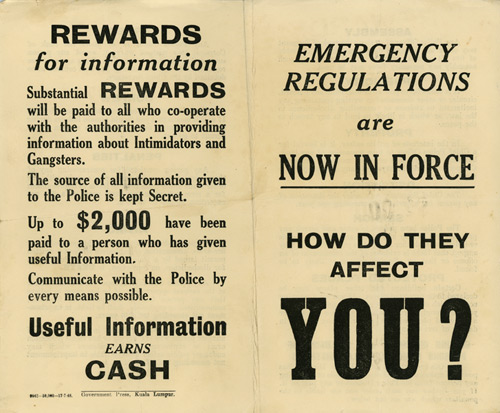 The Emergency regulations
The Emergency regulations
(Illustration courtesy of Lee Richards)The British Government printed a 4-page folded brochure entitled "Emergency Regulations are now in Force – How do they Affect You?" The inside of the brochure has sections such as; "Assembly", "Publicity", "Property", "Detention", "Search", "Arrest", "Curfew", "Penalties" and "Arms". The back page offers rewards for information. I note that the British call the Communist insurgents, "Intimidators and Gangsters".
Noel Barber tells us more about the British use of words as PSYOP:
Communist Guerrilla fighters are referred to as CTs, short for Communist Terrorists. At first they were officially labeled "bandits," until the British discovered that this word had unfortunate connotations. "Bandits" had been the identical term used by the Japanese and Chiang Kai-shek to describe Communists; since neither of these powers had been successful, the use of "bandits" by the British put them on a similar level in the eyes of the Malayan Chinese.
It is believed that by 1948 the guerrilla movement or Min Yuen (People's Movement) cadres had about 12,000 members. Meanwhile, the British deployed about 5,000 troops and a police force of 10,000. Within two years the British had reinforced their armed forces with an infantry brigade from Hong Kong and another from Great Britain.
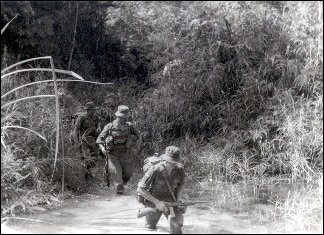 British soldiers on jungle patrol in Malaya
British soldiers on jungle patrol in MalayaA secret British Government Memorandum by the Secretary of State for the Colonies dated 21 December 1951 says about the Min Yuen:
The Communist organization is headed by a Secretary-General, with two or three staff officers. It is not known, but it is believed, that this central body is located somewhere in Pahang. The war is waged with two instruments, propaganda and armed forces. The Min Yuen or People's Movement (probably numbering about 10,000) is used for both: the armed bandits are recruited from them in the villages and it is the Mm Yuen who penetrates the Resettlement Areas, the schools, the villages and the Trade Unions with Communist doctrine. They also find supplies for the armed forces and undertake small ambushes. [
2]
Like all guerrilla forces, the MCP deliberately avoided battle wherever they were weak and likely to suffer losses. They 'hit and ran' and set up ambushes for the government troops hot on their trail. They attacked isolated police stations, rubber plantations and tin mines. They set up small ambushes, did the occasional political murder and committed sabotage as the opportunity allowed. To sustain its military activities, the MCP depended on the sympathy and support of the people. While the military arm of the MCP was conducting terrorist activities designed to dislocate the political and economic foundation of British rule, the Min Yuen was responsible for recruiting and acquiring supplies for the execution of a guerilla war.
The Communists were fairly successful in their campaign of terror, killing a total of 400 civilians and torturing many others during the first year of the uprising. Their activities did not extend into the urban centers, but they ran wild in the rural rubber plantations, tin mines, smaller villages and railway stations.
The MCP embarked on a protracted war, but the cost was high both in military and political terms. In the first three years of its operations, the MCP lost 2,842 men while the government security forces lost 971 killed and 954 wounded. Official statistics indicate that by the end of the 12-year Emergency, 6,710 insurgents were killed, 1,287 were captured, and 2,702 surrendered.
The Communists needed the support of the people. Mao Tse-Tung said that 'The guerrilla must move amongst the people as a fish swims in the sea.' The MCP needed to be able to move along the jungle fringe-dwellers to forage and trade for food and supplies. However, as they threatened the population to fuel the revolution, they alienated many of the people that they badly needed for support. The British memorandum explains:
…Communist efficiency has greatly improved… driven home by harrying the population at the point of a gun, the rest of it by peaceful and insidious means. One of the most serious features of the whole problem is the amount of protection money and payment in kind which are being made daily to the bandits. On the one hand, the rich Chinese are known to be paying large sums of money to prevent their estates and mines from being attacked; on the other, the Chinese laborer is passing food and clothing or stolen rubber and tin to the bandits through the wire of the Resettlement Areas or directly in the fields or jungle generally from fear but sometimes from sympathy.
Unlike the Viet Minh, the MCP was unable to rally the country to their cause by appealing to nationalism and unity. This was due partly to the ethnic composition of Malaya, with 49% Malay, 39% Chinese, 10% Indians and Ceylonese, and 2% others. Meanwhile, support for the MCP was mostly from about 500,000 of the 3.12 million ethnic Chinese. A British government document uses different numbers and says the population was approximately: 2,500,000 Malays, 2,000,000 Chinese, 500,000 Indians and 70,000 others for a total of 5,070,000 people.
We should also note that Malaya had no great nationalist leader like Mao Tse-tung or Ho Chi Minh to rally the people.
The MCP prepared written propaganda and continued to use terror in an attempt to intimidate and control the people. In Emergency Propaganda: The Winning of Malayan Hearts and Minds 1948-1958, Kumar Ramakrishna talks about the use of terror by the MCP:
In Bahau in October 1951 the MCP used both propaganda of word and deed to cripple the rubber tapping industry. They dragged two Chinese tappers from an estate lorry and in front of their horrified fellow workers, shot them dead. Three gang foremen also suffered the same fate. For three nights in row, pamphlets were distributed amongst the terrified tappers, warning them that if they did not stop work they would be punished as well. Fifteen terrorists dominated 6,000-7,000 tappers and brought to a complete standstill the tapping of rubber trees over 50,000 acres.
Communist propaganda is mentioned in an article entitled 1st Battalion Seaforth Highlanders in Malaya by Donald William Martin. He says in part:
My company was stationed in a small village, Kuala Krau, in Pahang. During our stay there, we were subjected to terrorist attacks although none of these were serious. They, the terrorists, would come in the night, shooting off weapons, shouting Communist slogans and scattering leaflets with Communist propaganda inside the barbed wire perimeter defenses. The gist of the message on the leaflets usually was, "Go home British soldier, this is not your fight."
Rui Xiong Kee wrote about Communist publications in autumn 2003. He pointed out that the Communists published several bi-weekly newsletters and newspapers during the emergency. Examples are Battlefront, War Information, Student News, People, News Brevities,Humanity News, the Beacon, True News, Battle News and Freedom News. He explains that they were written in the vernacular of the people in a matter-of-fact tone implying that the Communists were closely connected to the people. They all attacked and demonized the British and highlighted the 'Gestapo' actions of their police force. Examples of such stories are 'British bandits raped a 50 year old Malay woman,' and 'regular troops of the British imperialists raped a 12 year old Chinese girl.'
The master Communist propagandist who wrote most of the articles for these newspapers and arranged for their publication was named Osman China, Propaganda Chief of the Malayan Communist Party, 10th Regiment Malayan National Liberation Army. In 1955, after a year of food deprivation and living on bananas, tapioca, snake and elephant meat, China quietly surrendered to the British, bringing out many of his band and eventually talking another 40 terrorists to surrender. He was paid $80,000 for his services.
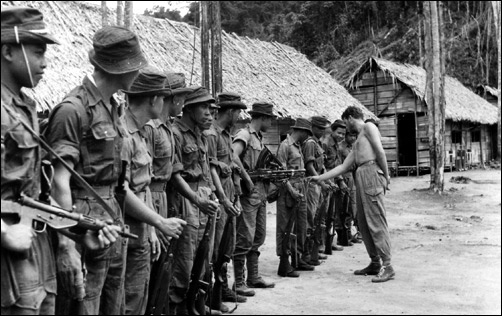 Malayan Police patrol based at Fort Brooke(Photograph courtesy of Roy Follows)
Malayan Police patrol based at Fort Brooke(Photograph courtesy of Roy Follows)Daniel Marston and Carter Malkasian talk about the British reaction in Counterinsurgency in Modern Warfare, Osprey Publishing, Oxford, UK, 2008:
The initial counterinsurgency strategy was developed by Major General C. H. Boucher, General Officer Commanding (GOC) Malaya. His approach was to use the army for large scale "sweeps" designed to locate and trap the most active of the Communist insurgents. Boucher also held the view that the Army was fighting a war, and that his soldiers should shoot to kill… What emerged was a policy of enforcing law and order through coercion or, in modern terms, a search and destroy policy.
The British made significant headway against the MCP in 1950. Under the direction of the retired Lieutenant General Sir Harold Briggs, who had considerable jungle experience while fighting in Burma during World War II, the shortcomings of the government were identified. These included the lack of population control measures, inadequate intelligence, and uncoordinated military, police and civilian measures against the guerrillas. From these considerations, the 'Briggs Plan' was formulated. The guerrillas would first be separated from the civilian population that sustained them, and then defeated through coordinated civil, military and police action.
Briggs was handicapped in that although he was given the title "Director of Operations," he never had control of the military, police and civil administration. The police and army continued to use what he considered excessive force against the Chinese. He was trying to "coax" the neutrals and guerrillas to return to the government while the uniformed forces were driving many away with violence.
The first part of the Briggs plan called for the large-scale resettlement of about 500,000 squatters in the jungle fringes to new villages. These subsistence farmers were the main source of food for the rebel army. Started in June 1950, this program resettled 423,000 Chinese squatters in 410 new villages by 1952. These new villages had a defense perimeter to ensure controlled entry and exit. The government gave every family five months worth of provisions and all the materials needed to build a house. This gave the squatters an immediate sense of ownership. The communists were now forced to come out of the jungle and into the open to search for food. It made them vulnerable to attack and ambush. In 1951 the British introduced the 'food denial' program called Operation Starvation. This program was designed to stop the smuggling of excess food to the Communists. The measures included ration reduction, punching canned food at time of purchase, strict checks by the guards on all personnel moving in and out of the villages, and forbidding meals from being brought to work areas. Communal cooking of rice was encouraged to prevent any private ownership of uncooked rice that might be smuggled to the Communists. The guerrillas were now forced to come further out of the jungle to meet their suppliers, who could be identified, 'turned,' and used as a source to set up additional ambushes.
W. G. Stefaniak tells us more about the year 1952 in his article entitled, "A Reconsideration of British Counter-insurgency Methods," South East Asian Spectrum, Volume 2, No. 1, October 1973.
In 1952 as the Malayan Races Liberation Army (M.R.L.A.) withdrew further into the interior, it was feared that the Malayan Communist Party would establish liberated areas among the timid aborigines who inhabited Malaya's interior mountain spine. To prevent the Malayan Communist Party using the aborigines as a source of food, the government sent out teams (usually special air servicemen and police) to win over these aborigines who numbered between 50,000 to 100,000 according to the various authorities. Landing strips were made and police posts were established in these remote areas to protect the aborigines from the Malayan Communist Party and the interior was gradually taken over by the government… A small aborigine force called the Senoi Pra'ak was formed to harass the communists and this force killed more terrorists in the last two years of the Emergency than all of the other Security Forces put together. Jungle forts and aborigine patrols and scouts also criss-crossed the Thai border area and reported on Malayan Communist Party activities there.
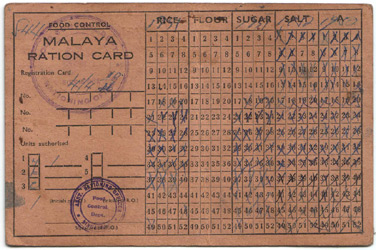 Malaya Ration Card
Malaya Ration Card
(Illustration courtesy of Benjamin Seet)As part of the British overall strategy of 'food denial' to control provisions and interdict supplies to the insurgents, this ration card was distributed and used from 1953 to 1954. Notice the columns for rice, flour, sugar, salt and miscellaneous.
Ramakrishna talks about the result of the food denial program:
In August 1951, just two months after food control began, four terrorists in northern Selangor surrendered, complaining that their gang had been reduced to eating fruit seeds in lieu of rice, and many were suffering from swollen and ulcerated legs.
While resettlement and food denial programs were the main control measures, other steps were also taken. For instance, there was a national registration. Every adult above the age of 12 was ordered to carry an identity card with his photograph, his fingerprints, and his personal particulars to include his permanent residence. Not only did this separate the Communists who dared not register from the lawful citizens, it also gave the British a database for the movement of people into the 'new villages,' a name selected to imply that there would be a new and better life for the squatters after relocation. A year later a law was passed allowing the authorities to relocate the squatters and to clean up the squatter areas. The squatters now received adequate protection from the Communist terrorists, land to build their homes, free material and assistance in building their homes, a government subsidy, free medical care; free schooling for their children, water, and good roads to the nearest township. Each new village was surrounded by a double barbed wire fence over seven feet high. Gates were manned around the clock and everyone was searched both entering and leaving. There was a 24-hour curfew outside the village and a nighttime curfew inside the village. There was always the possibility of mass arrests and individuals could be searched without warrant. The various civil, military and police services were better integrated and coordinated. Briggs reinforced the police, especially in the populated areas. Eventually, the size of the police force grew from 10,000 to 75,000. In all, the British had gone to war.
Of course, the Communists attacked the registration program. They printed leaflets and posters stating that the registration was a prelude to conscription, or to make it easier for the government to raise outrageous taxes on individuals. Thousands of small printed slips of paper in Chinese, Malay and Tamil threatened death to the "Running Dogs" that registered.
Sir Gerald Templer was appointed High Commissioner and Director of Operations in January 1952. Templer was briefly head of the German Directorate of Special Operations Executive in WWII so he understood unconventional warfare. His leadership provided the moving force that ensured the smooth and effective implementation of the plans formulated by Briggs. Templer reorganized the Special Branch (SB) to make it a more effective intelligence agency. The SB did not confine itself to police intelligence but was responsible for the overall collation and evaluation of intelligence derived from captured terrorists and documents, surrendered enemy personnel, double-agents, and informers. Templer built up the Malayan Home Guard, armed them with shotguns, and increased their ranks to 200,000 by 1954. The most significant aspect of Templer's handling of the Emergency was his desire to win the hearts and minds of the people. Thus, the Information Services Department and the Psychological Warfare Department kept the civilian population informed of government policies, communist atrocities and disruption activities. He believed that the people should be well treated and their grievances heard. He brought the concept of winning hearts and minds to Malaya, a term that would be used over a decade later by U.S. troops trying to win over the Viet Cong in Vietnam.
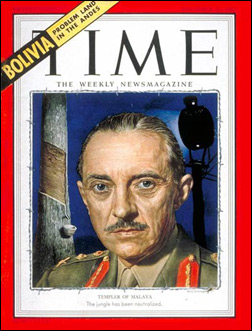 Sir Gerald Templer, featured on the cover of
Sir Gerald Templer, featured on the cover of
TIME magazine, December 15, 1952.Templer was apparently the moving force behind what might be the most successful counterinsurgency operation in history. He had the ability to operate on a number of different levels, military, political, intellectual and social, and was at ease in all of them. John A. Nagl gives an example of his vigor, energetic personal leadership, willingness to try new methods and take-charge attitude in Learning to Eat Soup with a Knife, the University of Chicago Press, 2002. The author points out that Templer arrived in Malaya on 7 February 1952. About six weeks later on 25 March, 12 members of a party sent to repair a water tower were killed in a terrorist ambush. Templer immediately punished the nearest town. He imposed a 22-hour curfew, cut the rice ration in half and closed the schools. He declared:
This is going to stop. It does not amuse me to punish innocent people, but many of you are not innocent. You have information which you are too cowardly to give.
Every villager was required to fill out a form naming known Communists and their supporters. The resulting information led to the arrest of 40 Communists and sympathizers. The curfew was then lifted.
Templer was a hands-on manager and was famous for flying to trouble spots. Sometimes his chastising of the villagers had humorous consequences. Noel Barber mentions such a case after a guerrilla ambush caused Templer to immediately fly to the nearest village where he harangued the collected inhabitants:
"You're a bunch of bastards," shouted Templer; and Rice, who spoke Chinese, listened carefully as the translator announced without emotion: "His Excellency informs you that he knows that none of your mothers and fathers were married when you were born."
Templer waited, then, pointing a finger at the astonished villagers to show them who was the "Tuan," added "You may be bastards, but you'll find out that I can be a bigger one." Missing the point of the threat completely, the translator said politely, "His Excellency does admit, however, that his father was also not married to his mother."
Templer is praised by Dr. Klev I. Sepp in 'Best Practices in Counterinsurgency,' Military Review, May-June 2005.
During the 1950s Malaya Emergency, British High Commissioner Sir Gerald Templer a declared antiracist strived for political and social equality of all Malays. He granted Malay citizenship en masse to over a million Indians and Chinese; required Britons to register as Malay citizens, elevated the public role of women; constructed schools, clinics, and police stations; electrified rural villages; continued a 700% increase in the number of police and military troops; and gave arms to militia guards to protect their own community. In this environment, insurgent terrorism only drove people further from the rebels and closer to the government.
Sunderland points out how Templer brought everyone into the fold:
Templer took office in February 1952. On midnight, 14 September, 1,100,000 Chinese and 2,630,000 Malayans became what were called "federal citizens."
The Psychological Warfare Department made use of leaflets written by ex-Communist terrorists in convincing the guerrillas to surrender. Loudspeaker aircraft were also used to convey to the guerrillas the futility of continuing the war. The British changed their military tactics. The army became a decentralized fighting force operating on a territorial basis. This was essential because in a guerilla operation there are no fixed battle lines. In this new type of warfare, patrols, ambushes, and 'hunting-squads' were the main type of military organization for fighting the Communist terrorists. With better intelligence, their encounters with the CTs were no longer by chance but now by deliberate action and systematic planning. The jungle war was essentially an infantry war. Armored vehicles were used primarily for transportation of troops. The Air Force only played a supporting role and never conducted large-scale air bombardments.
Counterinsurgency in Modern Warfare adds:
The best sources of intelligence were surrendered enemy personnel (SEPs). Insurgents tended to surrender for different reasons, including internal friction and, after 1952, shortages of food and an increasing sense of hopelessness. However, one of the key factors was the program of giving reward money to anyone providing information leading to the capture or surrender of insurgents.
In regard to village entertainment as a media for disseminating propaganda, the British brought film vans and acting troupes to the villages. Sunderland adds:
In any given audience, many of the spectators, most of who were children, had never seen a film before the mobile-van unit came to their village.
A special attraction was provided by troupes of surrendered enemy personnel. For a guerilla to leave the Communist Party was a profound emotional experience, akin to a religious conversion. These men, and in some cases women, were filled with revulsion against their former life and often with missionary zeal. It was only natural, therefore, to have them tour the countryside to lecture on their experience and to satirize guerrilla life. A typical party would be made up of ten ex-Communists traveling in a convoy.
The Secretary of State for the Colonies was not so positive about the propaganda and film campaign. He wrote in 1951 in regard to the Propaganda and Information Department, Film Unit, Public and Press Relations, and Radio:
This Department is in a confusion of divided loyalties and responsibilities and must be entirely reorganized under one head. At present it is inefficient…The Film Unit, whilst possessing 63 mobile vans and a film studio, has so far failed to produce any propaganda films of importance. Because Dato Onn is the Member in Charge of these services, reorganization may prove difficult, but such is the importance of this weapon that means must be found for undertaking complete reorganization under one chief who is a trained propagandist.
Before moving on we should also mention another major player in the British response to the Communist uprising. Sir Robert Thompson (KBE) was a former Brigadier General and counter-insurgency expert who had fought with the Chindits during the Burma Campaign of WWII. In the 1950's he served as Permanent Secretary of Defence for Malaya and was a major player in the defeat of the communist insurgency during the Emergency. He espoused the following five principals for a successful defeat of the Communists in Malaya.
1. The government must have a clear political aim.
2. The government must function in accordance with the law.
3. The government must have an overall counterinsurgency plan that encompasses security measures, military operations, political objectives, social and economic measures and administrative policy.
4. The government must give first priority to identifying and defeating the political subversives, not the guerillas. The communist front organizations and the civil apparatus are the ultimate threats to the nation.
5. When the insurgency has reached the stage of substantial military operations, the government must secure its base areas first, even if this means relinquishing some remote areas for a time to the insurgents.
He helped to draft the Internal Security Act (ISA), which gave the British colonial government the legal and constitutional right to arrest and jail anyone suspected of being a "subversive." They could be incarcerated indefinitely and without trial, whether or not they actually bore arms against the government, and whether or not they were members of the Malayan Communist Party. It basically gave the government carte blanche.
The Communists were also busy. Their attempts at spreading propaganda about the 'concentration camps' in the new villages had little impact. In October 1951 the MCP realized its tactical blunders in the use of terror, intimidation and murder and issued a Directive which said that instead of fighting and destroying the British, the primary objective and duty of all MCP members was to expand and consolidate the organization of the masses. It was too little, too late. The terrorists did have a brief moment of glory in 1951 when they were able to assassinate the acting British High Commissioner, Sir Henry Gurney. He seemed to have gone along with much of the violence against the ethnic Chinese and was quoted on one occasion as saying, "The police and the army are breaking the law every day." He believed that the Chinese would obey whoever had the most strength and will to win and he was determined that would be the Government.
In 1950 the psychological warfare objectives were changed to:
Create distrust and suspicion between leaders and led by stressing gulf between the advantages of benefits enjoyed by the Malayan Communist Party elite as compared with the latter.
Create doubt in ultimate victory by quoting from captured documents in which senior party members expressed uncertainty.
Counter enemy propaganda that those who self-renounced would be ill-treated or killed when their usefulness to the security forces had ended.
Promote dissention within units by stressing differences of treatment afforded to various ethnic, religious or racial classes.
Encourage desertion by emphasizing the rewards payable to the public for assisting surrenders and providing information.
Komer points out that the reward program was one of the most successful and cost effective PSYOP programs used by the British in Malaya. He says in part:
The heart of the government's psychological warfare was its rewards for surrender program. This addressed itself to the fact that killing an insurgent was – at least by any rational standards – exorbitantly expensive. Bribing insurgents to surrender, or others to provide information which would lead to their capture, was much cheaper. So bribes and rewards were set at levels which made them quite handsome by any standards...They ranged from U.S. $28,000 for the Chairman of the Central Committee…Down to $875 for a soldier…When an agent brought about the capture or killing of two or more insurgents, these sums were cumulated. For one coup in which an agent's information concerning an insurgent camp led to an air strike that killed fourteen out of sixteen insurgents, the agent was awarded his bonus for all fourteen – a total of $20,000.
By 1954 the Communists were defeated and the government was in the mopping up and consolidation phase. Malaya had instituted a more liberal citizenship regulation that enabled over one million Chinese to become citizens. As a result of the compromises worked out by the various ethnic groups, independence was achieved in August 1957. The MCP could no longer claim that it was fighting for the independence of Malaya. By 1960, the Emergency was officially declared over and the Communists were totally defeated and had to retreat to their sanctuary in the Thai -Malayan border. The victory was a tribute to the British who saw that the answer to the communist challenge was found not in military escalation, but in winning the hearts and minds of the people.
Psychological Warfare
Malaya was a hotbed of psychological operations during WWII. Both the Allies and the Japanese produced leaflets, posters and newspapers in an attempt to win the hearts and minds of the populace. To give an idea of the Allied campaign, leaflets were prepared that were coded CMA, SJM (Southeast Asia Command leaflets to Japanese troops in Malaya), SMA (SEAC appeals to citizens of Malaya to rescue pilots, etc.), and SMN (SEAC newspaper Victory Herald to citizens of Malaya). There were many other general codes for the Japanese troops in all the countries of Southeast Asia, but those we mention were specific for Malaya.
At the same time the Japanese were printing anti-British leaflets and posters in an attempt to attack and humiliate the white colonialists. My favorite is an image of the surrender of Singapore that was produced both as a color postcard and as an aerial leaflet. The illustration was from a painting by Miyamoto Saburo.
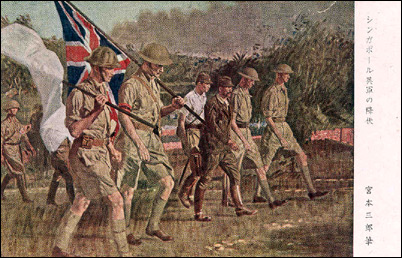 The Fall of Singapore
The Fall of SingaporeThe Japanese postcard description from the illustrated brochure that it came in says:
The fall of Singapore - The East Asian fortress under the intrusion of the British for more than a century - fell on Showa 15th year, the 2nd month, on the 17th day at 6:40 p.m. In a single file, bearing white flags, the British officers of the Malayan Command approached our mighty army to surrender. From the right: Commanding Officer Malaya, Lieutenant General Percival; Chief of the General Staff, Brigadier General Torrance; Staff officer, Colonel Sugita; Interpreter, Ling-zhuan; Chief Administrator of the British High Command, Malaya, Major General Newbiggen, who is holding the Union Jack; and Captain Wylde who serves as interpreter.
It is worth noting that the Japanese made use of PSYOP in their Singapore victory. Japanese General Yamashita was outnumbered three-to one and was nearly out of ammunition by the time he reached Singapore. Instead of acting cautiously, he cut off Singapore's water supply and dropped leaflets demanding immediate surrender. His bluff worked. When General Percival met with him hoping to negotiate, Yamashita blustered, demanded unconditional surrender and yelled, "Yes or no? Surrender of fight?" Percival had no idea that he had the stronger hand, and simply said "Yes."
When the Communist guerrillas took to the jungle in what was to become known as the Malayan Emergency, the British were ready to use psychological warfare once again.
F. H. Lakin wrote the classified
Army Operational Research Group Report, Number 5/56 - Psychological Warfare Research: its role in the Cold War.[1] This 9-page report was an epilogue of some of the British actions in Malaya with conclusions about successful campaigns mounted from 1952 to 1954 that might be of value in future counterinsurgency operations. The report was prepared after extensive interviews with terrorists who had surrendered. The prisoners were interrogated in Kuala Lumpur immediately after capture. One of the more interesting facts discovered by the researchers was that psychological operations played an important part in the surrender of about half of 431 prisoners interviewed. One of the prime reasons was the continual assurance of good treatment after surrender and the use of photographs and statements of well-known terrorist leaders who had defected. It was also found that news stories about Communist military defeats tended to destroy the confidence of the insurgents.
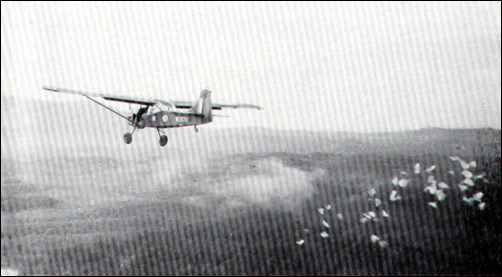 A Mark 4 RAF Auster disseminating propaganda leaflets.
A Mark 4 RAF Auster disseminating propaganda leaflets.The use of tactical leaflets combined with attacks by government forces were very successful. In Operations Hawk and Apollo in Pahang in 1954, the combination of aggression and leafleting was credited with 60% of all the surrenders including many 'hard core' Communist cadre.
The author discusses the 'To the Jungle' campaign where the insurgents are invited to return to the government:
Suitable leaflets were dropped on a wide scale throughout the Federation and voice aircraft broadcasts were made to the maximum degree possible. Of 31 terrorists who surrendered shortly after this campaign, 17 had received the message by one or both of the means used. Of those, nine were positively affected in the direction of surrender...
In regard to types of PSYOP media, the author says:
Air broadcasting and lorry-borne equipment were the subject of a long series of trials ...the fitting of voice aircraft operations into the general campaign raised many staff problems, but such operations have been going on now quite smoothly for two years. Loudspeakers operating from the ground against active terrorists were abandoned as their range and mobility were never really satisfactory; they are, however, used by the police and by the Information Service.
The evidence from Malaya indicates that psychological warfare played an important part in inducing disaffection and surrender
The report ends with four recommendations:
- Psychological operations should begin immediately when a military conflict is inevitable.
- Information about possible future enemies should be collected and saved to be used as part of psychological operations when needed.
- PSYOP officers should be trained in every phase of research to include areas where the military has no active role.
- The equipment for psychological operations such as printing presses, loudspeakers, leaflet dropping apparatus, etc., should be developed immediately.
One of the most prophetic statements from the 1950s report is:
In any such war that the United States of America is engaged, psychological warfare methods will be employed on a large scale.
They were certainly correct in that statement. Current U.S. policy calls for the use of PSYOP prior to, during, and after the end of hostilities.
As for the production of loudspeakers mentioned in point 4 above, Kumar Ramakrishna points out that there were at least three different loudspeakers used during the Emergency. After 1955, Magnavox was a powerful public address system mounted on an armored police vehicle could broadcast 2 1/2 miles. Stentor was an amplification unit that could broadcast 2 miles from the jungle's edge. The Thundererloudspeaker unit could broadcast a full three miles into the jungle.
Flight Lieutenant A. F. Derby, M.B.E. wrote an article entitled
Psychological Warfare in Malaya that discussed operations during the Emergency. He stated that the aim of the campaign in Malaya was to destroy Communist morale, to induce the terrorist to surrender, and in surrendering, to spread defection amongst his fellows. The British had complete domination of the air, and intelligence good enough to make the propaganda message very personal, sometimes on an almost man-to-man basis. The psychological warfare staff was made up of a committee headed by the Director of Operations, a staff officer, a civilian member of the Malayan Civil Service, a staff officer of the Information Service, a Royal Air Force Squadron leader and an Asian editorial staff.
In regard to the machinery of psychological warfare he says that the British used the Mark 4 Auster aircraft fitted with loudspeakers on each wing to broadcast to targets on the jungle fringes, isolated villages, and small targets near roads. The Auster is a single-seat aircraft, so the pilot must not only fly and navigate, but he is responsible for changing the audio tapes while in flight controlling the aircraft with the stick held tightly between his knees. The larger American C-47 Dakota aircraft has also been used for some of the loudspeaker, or as the British call them, 'voice' missions. The Dakota has a generator capable of powering four Tannoy loudspeakers affixed to the bottom of the aircraft which can broadcast over the jungle and to remote places where a large area must be covered.
The DC3 Aviation Museum website features an article entitled '
They Talked to the Trees' by Joe Neville. In it, the author tells us more about the voice aircraft. He says that Faith, Hope and Charity were the names of the three Voice-Dakotas of 267 Squadron based at Royal Air Force Kuala Lumpur, Malaya during the Malayan Jungle Campaign of the 1950's. They operated continuously for six years. He adds:
The three aircraft had been specially modified for this work. Slung under the mainframe of each were four loudspeakers delivering 500 watts of audio power. In the main fuselage a large diesel engine was anchored to the floor with huge bolts and metal tie bars. This supplied the required 240v AC to the four five hundred watt amplifiers situated in each corner of the main cabin.
Their size took up a major part of the main cabin. A voice operator's station facing aft was positioned on the port side just forward of the main door. From my logbook, at a glance a voice operation appears to average out at about 4 hours. Most flights were over uncharted territory.
The first voice aircraft trials took place in March 1953, in a DC3 loaned by the USAF. The trials proved successful. As a result of this two Valetta aircraft of the Far East Transport Wing were converted as voice aircraft. The Valetta aircraft turned out to be totally unsuitable for the task, due to loud engine noise and high stalling speed. The DC3 had a low stalling speed and a much greater mobility and audibility.
On Christmas eve 1955 we took off from the Kuala Lumpur airbase to circle the city and broadcast Christmas Carols to all the folks below. We spent 2 hours 45 minutes circling playing all the favorites.
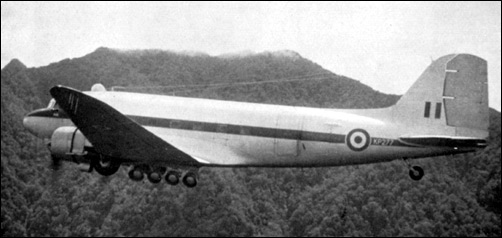 A 2,000 watt loudspeaker Dakota of the
A 2,000 watt loudspeaker Dakota of the
Voice Flight Detachment of 52 Squadron, RAFThe Dakota is also mentioned in an article entitled
Stop Press of the Jungle, by Flight Lieutenant H. G. Haines, Voice Flight Detachment of 52 Squadron, Malaya. Haines points out the loudness of the four loudspeakers, tested at 2000 watts. A Dakota was then borrowed from the Royal Australian Air Force in 1954, tested and found to be superior to the Valetta aircraft. A recommendation was made to replace the Valetta aircraft with Dakotas available in the United Kingdom. By January 1954 the British had three Dakotas and two Auster aircraft based in Kuala Lampur assigned to C Flight, of the 267th Squadron. As the war waged throughout the Malayan peninsula, the squadron became the 209th and later the 52nd. The propaganda messages were always the same:
All statements must be true. This principle has been rigidly adhered to in Malaya, and it is noticeable in statements by surrendered terrorists that they never doubted information heard from voice aircraft. Threats must not be used, unless the authorities intend to, and can carry out the threatened action. The messages must be brief and clear. Words or phrases must be carefully chosen.
The recordings are usually made in radio Malaya studios under ideal conditions. The recordings were made in Hakka, Mandarin, Malay, Cantonese, and other local dialects.
The aircraft flies at about 70 knots with the wings level so that the message can be beamed at a specific location. The plane makes squares, always turning to the left, working toward the center at 2,000 yard intervals.
Speaking of Australia, it's involvement in the Emergency began in 1950 with the arrival of RAAF aircraft and personnel in Singapore. Dakotas from 38 Squadron were deployed on cargo runs, troop movements and paratroop and leaflet drops in Malaya, while six Lincoln bombers of 1 Squadron provided the backbone of aerial operations.
In October 1955, the 2nd Battalion, Royal Australian Regiment (2 RAR), arrived in Penang. The 2 RAR crossed to the mainland in January 1956 to begin anti-communist operations. Over the next 20 months, as part of 28 Commonwealth Brigade, 2 RAR participated in a variety of operations, mainly in Perak, one of the main areas of communist activity. Their work consisted of extensive patrolling, watching for contacts in the rubber plantations and mounting a perimeter guard on the New Villages, settlements which the government had established to provide infrastructure and services in outlying areas in the hope of denying the guerrillas access to their support base.
2 RAR left Malaya in October 1957 and was replaced by 3 RAR in the same month. After six weeks of training in jungle warfare 3 RAR began driving the insurgents into the jungle in Perak and Kedah, separating them from food and other supplies. By late 1959 operations against the communists were in their final phase and many communists had crossed Malaya's northern border into Thailand. 3 RAR left Malaya in October 1959 to be replaced by 1 RAR. Although operating in the border region 1 RAR made no contact with the enemy and were forbidden to move into Thailand, even when the presence and location of communists was known.
In addition to air and infantry forces, Australia also provided artillery and engineering support, and an air-field construction squadron built the main runway for the air force base at Butterworth. Ships of the Royal Australian Navy also served in Malayan waters, and Australian ships had occasion to fire on suspected communist positions in 1956 and 1957.
Roy Follows was a Police Lieutenant with the Royal Malaya Police for about nine years during the emergency. For more than five years he was engaged on jungle operations as a platoon commander with the 10th Police Jungle Company and the 4th Police Field Force, both of which were based in Johor. He took part in some small psychological operations concentrated on a few villages outside Kuantan Pahang. He says:
I was based in one of the villages, and the other two or three were in my area. The operation was called 'Jack In The Box,' and run by a British chap from the PsyWar Department. He gave me piles of leaflets which were to be to be distributed around the villages, all at the same time. I placed them at first light. According to him, this sudden impact of all the villagers waking up and finding the leaflets would be a shock to them. I sometimes came across leaflets in the Hutan [forest] while on patrol.
He also mentions the loudspeaker aircraft:
I also heard the 'voice aircraft' asking the Communist terrorists to throw in the towel. When you could not see the plane, it was weird to hear this booming voice coming from somewhere above the trees. I did not like the idea of terrorist traitors receiving these huge amounts of blood money. The more of their so-called comrades they could set up to be killed, the richer they became. They were nothing more than ruthless killers whose slate had been cleaned and now had changed sides motivated by money. Many of them had been responsible for the most appalling deeds. There was a sliding scale paid rate almost like union rules; in other words, the higher you were in the communist chain of command, the more cash you received. Then there was a similar scale for arms. A Bren gun was worth more then a rifle and a grenade more than a round of ammo. I understand that some of them are now rich business men through their ill gotten gains, enjoying life under false identities in Spore [Singapore], Malaysia and Australia.
He concludes with a mention of small unit actions behind the lines.
We formed a "Special Operation Volunteer Force" (SOVF). It was made up of surrendered terrorists. The SOVF was a shadowy, little known unit. By 1957 there were eight or nine platoons of SOVF throughout Malaya, each under the command of a Police Lieutenant. With years of jungle warfare under their belts, these hard-core former terrorists would use all kinds of tricks, including PSYOP and "black" tactics to eliminate their former comrades. They not only spread confusion amongst the CTs, they also dispatched a good number of them.
In fact, the SOVF was formed in 1953 and consisted of about 180 ex-Communists grouped into twelve platoons of fifteen men each. The men and women signed up for 18 months, lived in police compounds and were paid about the same as junior policemen. Once their tour was over they were released into Malayan society with a clean slate.
Some "special operations" are mentioned in the 2005 Lawrence E. Cline monograph Pseudo Operations and Counterinsurgency: Lessons from Other Countries:
One of these operations typified the use of pseudo teams. A Special Branch officer established links with a MRLA section leader by arranging for his wife to deliver her baby in a government hospital. After becoming closer to the leader, the Special Branch officer made a deal with him. The leader led a column of six insurgents out of the jungle into a deliberate ambush in which the leader was carefully identified ahead of time and spared. Chinese British soldiers then donned the dead insurgents' uniforms and were led back into the jungle by the MRLA member. From there, they operated against higher ranking members of the insurgency.
The British also used pseudo-guerrillas for some psychological operations including disguising some troops as MRLA members, then launching a false bombing raid on their position. The troops were made up to look wounded and then sent into areas where they would encounter insurgents and spread tales of the effectiveness of British targeting. In general, however, the pseudo teams were used for intelligence collection and to target guerrilla camps for bombing raids.
Cline attempts to explain why the Malayan revolutionaries were so easily "turned":
Robert Thompson, one of the principal civilian architects of the counterinsurgency campaign argued that the captured insurgents, needed to "belong" to some organization in place of the Communism they had renounced; he believed they tended to turn to other ex-Communist Terrorists for guidance in the new world into which they had just emerged. In a strange way they could only justify their escape from Communism by being personally involved in the struggle against it, which was why time after time they begged to lead patrols back into the jungle to attack their former comrades.
Another author offered a more practical reason for the willingness of captured or surrendered insurgents to cooperate: They needed "to kill off all the Communists who knew them, and knew of their defection or capture, before this news could be spread around to the Traitor Killing Squads, which might extract retribution from relatives." Whether from practical considerations or more complicated psychological factors, surrendered or captured MRLA members tended to cooperate with British authorities once under their control.
The British used the same tactic against the
Mau Mau, using surrendered terrorists to enter the Bush and interact with their own comrades before ambushing them. The Americans did something similar in Vietnam, the Phoenix Operation, where through the use of former Viet Cong and informants they identified the infrastructure of the Communist movement in a local village or area and then took military action.
Bortree mentions three black and deception operations.
The British learned that maintaining operational security was difficult because the insurgents watched those open areas where parachutists might land. Surprise was impossible. In 1950, the British SAS developed a "tree jumping" harness that allowed paratroopers to insert through the jungle canopy. They could then remain suspended in the canopy until after dark, when they would lower themselves to the ground. The British perfected this method and were able to insert into insurgent territory with great success.
The British told the Communists in The New Path News that a typical patrol lasted two weeks. In reality, they lasted about 100 days. Paratroops would link up with patrols and replace them or wear their uniforms to return to base. The Communists, watching carefully believed they knew how many patrols were in the bush at any given time, but they were always underestimating the actual number of troops in the field.
The paratroopers also inserted into the jungle using deception. Knowing that the insurgents counted the troop transport aircraft leaving the field, the airborne troops would often fly in PSYOP and loudspeaker aircraft. Later, using the same method first used at Normandy, the British started to drop dummy parachutists. The Communists were never able to get a good fix on the number of British troops in the field.
The British mention both black and deception programs in a government memorandum:
Deception should be organized with the chief objects of discrediting the bandits' sources of intelligence in the Min Yuen by the infusion of information soon proved to be false or valueless; and harrying the bandits by spreading signs and rumors which will force them to keep on the move.
The British "Black" or Counterfeit Propaganda Department apparently it was not properly utilized because:
This Department hardly exists, but could do useful work. Its chief concern is the sporadic production at long intervals of a bogus Communist newspaper. The Department is very much understaffed. Occasional hours are devoted to it by the head of the Special Emergency Information Department. It employs one Chinese cyclostyler full-time and enjoys the part time co-operation of one Chinese literary expert.
There was also a Military Subversive Activities Section that existed for a short time but was abandoned. It could do useful work with suitable staff. The memorandum concludes:
The Black Propaganda Department and the Subversive Activities Section should be increased, given expert chiefs and placed under the control of the Director of the Intelligence Bureau to the Deputy Director of Operations.
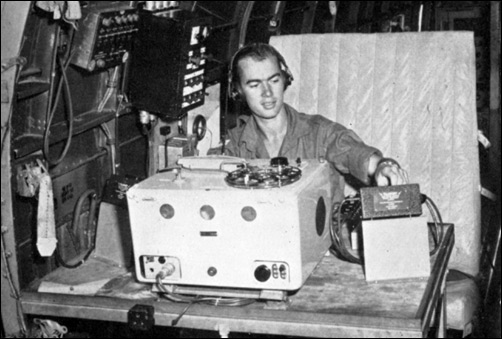 Broadcasting from inside a Dakota Voice aircraft.
Broadcasting from inside a Dakota Voice aircraft.The radio messages are short and meant for tactical rather than strategic purposes. A message might start, 'Come out and start a new life.' It will tell of guerrillas who have been killed or who have surrendered. It might bear a message from a defector to his comrades back in the jungle telling them of the good treatment he has received at the hands of the British.
The Valetta cargo aircraft was used for dropping leaflets from about 400 feet over the Malayan jungle. At first the side door of the aircraft was opened and the crew dumped the leaflets out into the slip-stream. As the war against the insurgents continued, the technique was refined and they dispatched bundles of 5,000 leaflets each by means of a static line. The latter method is more accurate and gives a very even distribution of leaflets over 1000 square yards. When a very accurate pinpoint airdrop is required the Mark 4 Auster was sometimes used as was the North American AT-6 Harvard used by the Malayan Auxiliary Air Force.
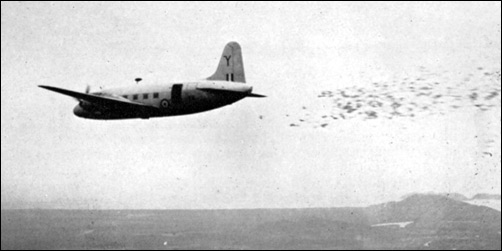 A Royal Air Force Valetta drops leaflets from 400 feet over the Malayan jungle.
A Royal Air Force Valetta drops leaflets from 400 feet over the Malayan jungle.The Far East Air Force / Monthly Intelligence Summary, Sep 1954, Pt II, adds:
Leaflets were usually dispatched from supply-dropping aircraft of the medium range transport force, and occasionally, bombers of the offensive support force at the conclusion of an air strike. As on supply drops, the No. 55 Air Despatch Company of the RASC provided the dispatching personnel on leaflet dropping sorties, with loads of up to 800,000 leaflets in Dakota or Valetta aircraft. It was found that a good distribution was achieved over an area 1,000 yards square by dispatching 5,000 leaflets at a time at the end of a static line.
Malcolm Postgate says in Operation Firedog. Air Support in the Malayan Emergency 1948-1960, London, HMSO, 1992:
During the entire Malayan campaign, nearly 500 million leaflets were dropped on more than 2,500 sorties and nearly 4,000 hours of aerial broadcasting were completed on a further 4,500 sorties by aircraft of the air transport support forces.
There have been estimates that over 5,000 different leaflets were dropped between July 1948 and July 1960, based on the coding of these leaflets over the 12 years. The later leaflets incorporated an alphabetical code indicating the Malayan state targeted. The leaflets might contain information gathered from captured documents or gleaned from local contacts. The main theme of the leaflets is always that Communists who surrender will be treated well, receive medical treatment, food and their safety is guaranteed. Some of the main concepts of the tactical leaflets are:
The group photograph which shows the surrendered terrorists in obvious good health and in company with other surrendered comrades.
A personal letter written in the recognizable handwriting of a former comrade.
Appeals from relatives for an individual not to waste his life. When these appeals come from wife to husband, father to son, or from other close relatives, the appeal can be great.
Declarations be leading personalities which point out the futility of further resistance and promise fair treatment to those who surrender.
Appeals to groups who are known to be suffering from jungle illnesses or starvation, promising them medical treatment and good food.
On a monthly basis strategic leaflets are dropped on targets known to be hiding places of terrorists, courier routes or contact points. These leaflets are often of the 'divide and conquer' type and point out the difference in treatment between the terrorist leader and fighter, or ask 'Why fight against the masses?' Others offer medicines for the sick, rewards for information, and attempt to exploit any perceived weakness of the guerrilla. The reward program was very successful. In the first six months of 1951, the Government paid out $500,000 for information, defection, and weapons surrender.
W. G. Stefaniak discusses the reward campaign:
Thanks to Voice Aircraft flying over the jungle and broadcasting terms of surrender and rewards, and RAF drops of leaflets setting out the terms (and also often carrying a picture of a thin emaciated surrendered enemy personnel (S.E.P.) at the time of surrender and the same fellow fat and happy a month later) and constituting in itself a safe conduct pass, the potential S.E.P. was informed of what he could expect if he surrendered.
The S.E.P was especially tempted by the huge rewards offered if he surrendered and led the British back to his old camp or alternatively, if he brought in a party of terrorists to surrender with him (a sort of special "group price" for the S.E.P. showing such initiative). Rewards varied from 30,000 pounds for Chin Peng to 250 pounds for an ordinary non-ranking bandit. The S.E.P. received half of this if he brought in his comrades or led the British back to his camp. The rewards were more than the average plantation worker, peasant, or mine laborer could make in a life-time. It was often criticized by government officials as being a rather unfair system as a hard-working Malay policeman would never earn as much as a S.E.P. who either brought in some of his friends or led the British to his camp. However, the results justified the expense. It would have been a thousand times more expensive to capture terrorists by huge useless army operations in the jungle. The reward system was cheap in comparison and the results were often spectacular. In 1952 for instance, the dreaded "Shorty" Kut's bodyguard brought in Shorty's head and claimed the 20,000 pounds.
Ramakrishna discusses rewards. He says that the Government had been offering small rewards since the start of the emergency. During the first five months of 1950 $350,590 had been paid for information. In December 1950 the rewards were raised and the Secretary General of the Malayan Communist Party was worth $60,000, Politboro members $50,000, and $2000 for the common foot soldier. Six months later all the rewards were raised again with the Secretary now worth $80,000 and the foot soldier $2,500. Weapons were also paid for and a Bren or sten gun was worth $500, while rifles, pistols and revolvers were worth $300. As the rewards rose the defections increased the Party commissars no longer attacked and ridiculed the government leaflets, they now told their members not to read them at all.
Komer quotes the complaints of an Australian soldier:
Terrorists who were caught were treated like murderers, while those who surrendered were treated like kings.
Barber discusses the rewards. The Communist leader Chin Peng was worth $250,000 alive, and $125,000 dead. Live terrorists were always worth twice as much as dead terrorists because they could be questioned and intelligence could be gained. Informers leading the police to dumps were lavishly rewarded at the rate of $50 for a machine-gun, $10 for a rifle and $1 for every bullet.
When an informer offered to lead officers to a dump hidden half way up a hill beneath a stand of trees they found a dozen pits, each one lined with timber and containing the circular metal drums in which the arms had been parachuted to Force 136 (during WWII):
Police headquarters was delighted, but also dismayed at the amount of the reward, for at the ruling prices the informer was eligible to collect more than $100,000.
Some leaflets were dropped on civilians, exploiting their distaste at being forced to plant food or work as a laborer for the guerrillas. The farmer is warned that his crops will be destroyed before he can hand them over to the terrorists and advising him to immediately leave the area and walk toward the government lines. One such leaflet stated:
You can hide your farm for a time, but sooner or later we will find it and destroy it.
Citizens are reminded that it is their duty to inform the government of rebel movements. Since some of the Malayans are illiterate, a few of the leaflets consist of just cartoons and pictures. They are always checked by a group of ex-terrorists before being accepted for dissemination.
New Path News from 1955 (Translated copy)
It wasn't only leaflets that were disseminated amongst the Malayans. The British also published an anti-Communist newspaper called New Path News (Sin Lu Pao). The newspaper was first distributed in September 1948. The translated copy of the newspaper depicted above first appeared in Derry's book … Some of the featured articles are; "Another Communist leader killed," "Female terrorist killed," "Anti-bandit statistics for March" and "Shameful affairs in the jungle."
Some terrorists have stated that the leaflets are persuasive. One said:
After the attack on our cultivation area we fled to another area where we saw many government propaganda leaflets and safe conduct passes. I picked up some of the leaflets, intending to use them when coming out to surrender. A few days later we heard voices coming from an airplane calling on us to surrender and offering good treatment. We all agreed to this suggestion.
Another defector said:
My mind was full of thoughts of my girl friend, starvation, liquidation, the contents of government leaflets, and voice aircraft. Finally the government propaganda won and early in the morning I got up and ran away.
Ramakrishna points out that a 1954 interrogation of 343 Chinese defectors found that the most common reason for surrender was dislike of their leaders. The MCP broke promises, had irksome internal policies and was insensitive toward its own rank and file. The British used letters from these defectors to cause further dissatisfaction. A 1952 leaflet-letter by a former Deputy Platoon Leader says in part:
Comrade! You can see that we never have full meals, warm clothing, or secure accommodations in the jungle. When we get sick there is no medicine...
When the lower ranks fall sick and ask for assistance, they will be regarded as being unable to bear hardships, as being too argumentative, in short, as exhibiting "bad manifestations."
Comrades! The upper ranks can make love in their secret huts, but if you want to find a lady friend, then you will have to wait until there is any left over from the upper ranks.
By the early 1950s, most leaflets dropped in the jungle had a safe conduct pass on the reverse for those terrorists who wished to defect. Many were signed by the High Commissioner and promised good treatment, food, cigarettes and medical attention. In addition, other leaflets like "Hints and Advice on How to Surrender" were produced.
Ramakrishna points out that since terrorists faced difficulties in surrendering, leaflets should tell them exactly how to surrender:
Every leaflet dropped on the jungle thus had a safe conduct pass on the reverse for the instruction of those keen to defect. It was signed by the High Commissioner and promised good treatment, food, cigarettes, and medical attention... A Pahang surrendering enemy prisoner came out after reading the leaflet on "Hints and Advice."
Leaflets were printed in a mixture of bright colors like red, yellow and orange and dull colors like grey, blue and green. This was because terrorists would not dare pick up bright leaflets for fear of being caught by their leaders, and w2ould only risk picking up the less obvious colors.
He lists the aims of psychological warfare. They were:
To attack the morale of the armed forces of the Malayan Communist Party and their supporters by:
(a) Undermining the confidence of the Communist Terrorists in ultimate victory.
(b) Publishing the advantages and methods of surrender.
(c) Creating dissension and distrust between the leaders and the rank and file.
(d) Encouraging the elimination of the Communist Terrorists by the publishing of rewards.
In regard to leaflets and voice loudspeaker aircraft Isaac says:
The main attack on the Communist Terrorists in the jungle has been through the medium of leaflets. In this connection during 1954 RAF Valettas carried out 328 missions airdropping 73,034,500 leaflets, whilst RAF Austers and ground distribution accounted for 30,726,000 a total of 103,760,500 leaflets, comprising 500 different leaflets.
The voice aircraft as a psychological warfare weapon has proved most successful. During 1954 the RAF Voice-Aircraft Flight consisting of 3 Dakotas and 2 Austers flew 1081 tasks. The aircraft serviceability enables immediate tactical operations to be met, but gives no room for extended planned operations or strategic campaigns. Messages are usually personal consisting of about 50 words lasting 30 seconds.
He lists the costs of the program:
(a) Personal Emoluments: and other charges amount to $250,000 (£29,155) which pays for a staff of 4 officers and editorial and clerical assistants.
(b) Special Expenditure covering operational production costs amount to $700,000 (£81,662) annually, of which leaflets take up $400,000 (£46,664) and newspapers $200,000 (£23,332).
(c) Voice Aircraft production charges are negligible. The aircraft operational costs are borne by the RAF.
(d) Mobile Public Address Units: The 90 Units establishment and running costs amount to approximately $1,150,000 (£145,825) per year and are borne by the Information Services.
(e) Total costs to Federation Government approximately $3 million. (£349,998).
Counterinsurgency in Modern Warfare concludes:
Propaganda came in many forms: pamphlets and newsletters in the local languages were widely distributed; radio broadcasts became important as individuals started to buy transistor radios and receivers were placed in communist centers in new villages and regroupment areas; and mobile film units toured the new villages showing commercial films along with films specially developed in the Malayan Film Unit.
The Leaflets
There are a great number of leaflets known to have been dropped on Malaya. We will show some of them here although many are without translations. This is a living article and will be updated as we receive new images and translations. We ask any reader with information or comments to write to the author at the address at the end of this article.
Komer states that 3.75 million newspapers and 50 million leaflets were distributed by the British in Malaya in 1949.
Although the war was officially declared over in 1954, it appears that leaflets were still being dropped on some holdouts as late as 1958. The Sunday Times of 13 July 1958 said in part:
Royal Air Force aircraft today began scattering seven million leaflets over the Malayan jungle, telling the Malayan Communist Party of one of the most closely kept secrets of the emergency - the surrender of 118 terrorists in Perak State.
Half a million leaflets have already been dropped over the jungle forty miles north of here (Kula Lampur) in an attempt to reach fourteen terrorists, who are all that remain of the once strong Communist force there.
Between them, the 118 have about 30,000 pounds in reward money, which they earned for bringing out arms and ammunition, and for persuading others to surrender.
639 separate voice messages were recorded in 1956 and 2,200 sorties flown by aircraft to broadcast them. Over 100 million leaflets were dropped in 1956. Komer adds:
One series of 20 million announced the outcome of truce talks between Chin Peng and the Tungku and the end of the Malayan Government amnesty offer. Another series of ten million stressed the end of the amnesty and drew attention to the coming Chinese New Years and thoughts of family reunion. A third series of ten million warned that the coming independence in the following year would in no way alter the determination of the government and people to destroy the Malayan Communist Party and to end terrorism.
| |
Air Despatcher L/C Ken Thomas of 55 coy AD, RASC, throws out
propaganda leaflets over the Malayan jungle in 1958.
(Photographs courtesy of Norman Doctor) |
In regard to the preparation of British leaflets,
The Falling Leaf, publication of the
Psywar Society, Issue 4, 1958, features a letter from a Malayan PSYOP specialist to a member:
You will not find much change from the specimens sent last year, unless perhaps a slightly greater use of cartoons. We still concentrate mainly on personal approaches to individual terrorists whose circumstances are known to be unfavorable, making use of letters from their relatives whenever possible. Numbers 4907 and 5000 are examples of this.
Three sets of leaflets in English, Chinese, Malay and Tamil, numbers 4580, 4786 and 4900 are a special 'Merdeka' ('Freedom') offer of very attractive surrender terms valid from September to the end of 1957. The results were so good that the offer was extended to April 1958, and then to 31 July 1958. We dropped 115 million leaflets during 1957. We have dropped 60 million in the first half of 1958.
Komer points out that in 1958 there were 90 mobile vans and four boats that allowed information officers to visit about one million people – one sixth of the population – each month.
As long as we are counting leaflets I note that the Internet Encyclopedia
Wikipedia adds:
The Psychological Warfare Section produced about six million leaflets each month, which were packed into bundles of 2,500 each at the Kuala Lumpur Royal Air Force Station. The majority of the leaflets were developed in light yellow sand or deep brown earth colors to blend in with the ground, in order to enable comrades to steal glances at them, without fear of undue attention.
There was also a Malayan film unit, troops who performed plays satirizing guerrilla life, three radio stations broadcasting in different dialects, and a host of papers, publications and magazines.
Merdeka Leaflet Translation
ATTENTION
ESPECIALLY IMPORTANT MESSAGE
Since the federation of Malaya achieved independence on 31 August 1957, in the first seven months
215 MCP PERSONNEL
HAVE COME OUT TO ACCEPT THE MERDEKA OFFER
This number includes high ranking personnel who hold posts like Border Committee Secretary, Regional Committee member, etc. Even these high ranking personnel have realized that the Merdeka Offer is a good offer to accept.
THE PRIME MINISTER OF THE FEDERATION, TUNKU ABDUL RAHMAN, IN A PRESS CONFERENCE HELD ON 27 MARCH HAD THE FOLLOWING WORDS TO SAY TO ALL MCP PERSONNEL:
215 of your comrades have already accepted the Merdeka Offer which is the largest number for any similar period since the emergency began.
This merdeka offer is still open, and is being extended until 31 July. I know there are many more of you who want to come out.
If any of you were thinking of holding out in the mistaken idea that operations against you will be relaxed after my target date of 31 August 1958 I give you this warning.
THERE WILL BE NO RELAXATION WHATEVER
AFTER THAT DATE.
| 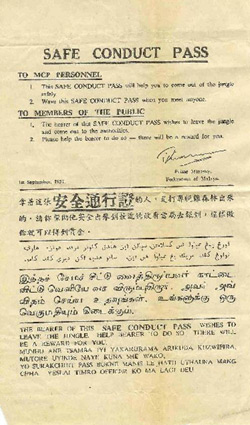 |
4786/HPWS/181, THIS MERDEKA OFFER IS NOW EXTENDED TO THE 30TH APRIL 1958.
(Illustration courtesy of Norman Doctor)
Leaflet 4786/HPWS/181 is a two-sided Merdeka amnesty leaflet. The code "HPWS" stands for Head, Psychological Warfare Section. On the front it depicts the letter to the insurgents at left signed by the Prime Minister, Tunku Abdul Rahman, and the English language text along the right side and bottom reads:
THIS MERDEKA OFFER IS NOW EXTENDED TO THE 30TH APRIL 1958.
ATTENTION
THE GUARANTEE THAT GOVERNMENT WILL NOT PROSECUTE THOSE COMMUNIST HELPERS WHO ASSIST IN INDUCING M.C.P PERSONNEL TO ACCEPT THIS OFFER IS ALSO EXTENDED UNTIL 30TH APRIL 1958.
The back of the leaflet features a safe conduct message in English and the three main Malay languages. It is:
SAFE CONDUCT PASS
TO MCP PERSONNEL1. This safe conduct pass will help you come out of the jungle safely.
2. Wave this safe conduct pass when you meet anyone.
TO MEMBERS OF THE PUBLIC1. The bearer of this SAFE CONDUCT PASS wishes to leave the jungle and come out to the authorities.
2. Please help the bearer to do so - there will be a reward for you.
Notice that the leaflets no longer use the word 'Surrender,' but instead say 'come out.' It was believed that this would make it easier for the Chinese guerrilla to defect while saving face.
John C.W. Field mentions the Malayan Emergency leaflets in his book, Aerial Propaganda Leaflets, Francis J. Field Ltd., Sutton Coldfield, England. He says in part:
Leaflets in Malaya seem to have been of two main types; those explaining to the terrorists the futility of their ill-spent campaigns, and those inviting them to surrender and hand over information concerning the whereabouts of Communist Party members. Three languages were in use; Chinese, Malayan and Tamil. One of these (452) in Chinese, was from the bandit Lam Swee who had surrendered, and was writing to his 'former comrades in the jungle.' The leaflets are found on blue, orange and yellow paper, according to the language.
No. 452, A Message from Lam Swee to His Former Comrades in the Jungle
(Illustration courtesy of Lee Richards)
This leaflet from Lam Swee is rather crude and seems to be handwritten on a blue paper. The text on the front is:
Dear Comrades:
I surrendered at Bentong, Police Station in Pahang on June 27, 1950. Many of you may not understand why I took this step. I want therefore to tell you why I have changed my mind about the Party. The policy of armed terrorism followed by the Malayan Communist "Central" is entirely against the wishes of the people. The establish ment of the New Central of the M.C.P. does not comply with the principle of internal democracy. Certain responsible persons in the Central are always doing the things they want to do. During the anti-Japanese campaign, after the Peace and even now they are all doing the same – doing anything they like. They merely talk about Revolution vaguely. That is why I want to make the following straightforward statement to you:
(1) It has been proved by historical fact that the so-called "Democratic Centralized System" adopted by the M.C.P. is actually a democratic dictatorship. From the anti-Japanese period to the struggle times after Peace, there were lots of indiscriminate actions which no subordinate had the right to query. The corrupt practices of the Central Commissars are well known. Subordinates who try to make suggestions to the superiors are condemned as attacking the leadership and they are given severe penalties. The present Central Commissars were not appointed through any legal process inside the Party. The so-called new Central consists of a few Commissars favored by Lay Teh. After Lay Teh left, comrades of various ranks repeatedly demanded the re-election of the Central. Such demands were regarded as illegal and an act of treachery to the party. When we requested the convening of the All Malaya Party Representatives Conference, they said we were trying to disrupt the Central. About all these facts you, the Comrades, know better than I do. You are indignant but dare not say anything.
(2) The M.C.P. says that they are fighting for the interests of the people. But what they are doing are murders, robberies and destroying the peaceful living of the people without any reason at all. They forced the people to follow the lawless path and caused thousands to desert their families and to move about in hunger. "Fighting for the People" in fact means to encourage the people to fight for the Party and to force many ignorant youths to sacrifice themselves for the M.C.P.
(3) What the M.C.P. calls "Intensification of Party Feeling", as a remedy to personal defects is actually a method to push junior members and convince members to fight and sacrifice their lives on the battlefield. In this way they can serve devotedly as slaves of the few self-imposed leaders.
(4) What the M.C.P. calls "Democratic Freedom" is, in fact, a term used by the present Central leaders to strip you of your freedom and rights. At present all you can fight for is the freedom to walk in the jungle, the right to carry the daily transport and to march to the fighting front. You can sacrifice your lives for a few leaders who merely abstractly talk about Revolution.
The back continues:
Dear Comrades!
I do not want to see the M.C.P. Central continue to use such treacherous and poisonous schemes to end your precious lives. I want to call upon you to profit from the lessons we have learned from the experiences we gained in the anti-Japanese war, and to call upon you to repent and to look for a way out for yourselves.
In my personal experience during the past ten years or so of Malayan Revolution I have clearly discovered the true face of those Central leaders of the M.C.P. I am now wide awake and no longer to be deceived. That was why I voluntarily surrendered to the authorities.
It has been almost four months since my surrender. During these months I have seen how those who have surrendered in various States have been treated. I am therefore in the position to tell you that we have all been treated well by the Government. We have not been sent to jail. From now on I am going to try to make myself a new and a free man. In the interests of your own future I sincerely and honestly point out to you the following:
(1) If you sincerely and honestly surrender you will also be well treated by the Government and will have an opportunity to meet with your wife and children, your parents, brothers and sisters again. You will also have a chance to become a free man and to get a suitable job.
(2) If you prefer to remain unconvinced and are willing to sacrifice yourself for the leaders of the M.C.P. then let me tell you this. Even though you may be lucky enough not to be killed during the struggle you will eventually know your final fate – there can only be one end. Let my experience also be your experience. I want you to consider these words very carefully and see if I am right.
OUR SLOGANS:
(1) Immediately exterminate the Communist Party leaders and surrender to the authorities.
(2) Immediately leave the jungle and restart our Free Life.
(3) Help to restore Peace and Order in Malaya.
LAM SWEE
October, 1950.
During the Anti-Japanese Period, Local Commissar, South Johore Branch, Malayan Communist Party.
After the War, Vice-President, Pan-Malayan Trade Union Federation.
After June 1948, Political Commissar attached to Headquarters, 4th Corps South Johore
Field continues:
No. 459, Rewards for the capture of Communist Terrorists
(Illustration courtesy of Lee Richards)
Another typical leaflet is 459, which can be found in all three languages. This sets out the rewards to be paid for anyone giving information which would lead the security forces to the capture or extermination of a bandit. The rewards, varying from 30,000 dollars in respect to the Secretary General of the Central Executive Committee, to 1,000 dollars in respect of ordinary party members, were tabulated on special moisture-resisting paper. Most examples of this type date from December 1950.
A press report of 6 May 1953 stated that the British High Commissioner in Malaya (General Sir Gerald Templer) had allowed his signature to be applied for the first time to safe conduct passes, since previous unsigned appeals had been a failure. The new surrender leaflet is in the three native languages and English:
The bearer of this pass wishes to surrender.
He is to be given good treatment, food, cigarettes and medical attention if required.
He is to be taken as soon as possible to the nearest senior police officer.
Later, on 8 May 1953, the associated Press reported that 4 million surrender passes were dropped by the R.A.F. during the month of April.
Ramakrishna identifies other leaflets such as 'Attacks on worker's homes' (348), 'Extortion from farmers' (349), 'The killing of worker's children' (351), and 'Damages to worker's transport' (362). He translates leaflet 367:
If you want to save yourselves, the only thing to do is leave the jungle.
If you do not do so, the Government will use more troops and bombs against you.
Your doom will be certain.
COME OUT QUICKLY AND SAVE YOUR LIVES.
He says that leaflet 341, produced in March 1950, depicts the photographs of two dead terrorists, Chee Kiong and Ah Fong alias Eng Seng. The text in part is:
Why suffer the horrible fate of these two foolish men? Why not take the opportunity to surrender given to you by the Government before it is too late?
Why endure unnecessary hardships and starvation and face death in the jungle, when food and medical attention await you when you surrender?
Those who voluntarily surrender have all been well treated. None of them have been sentenced to death for carrying arms.
He points out that during 'Anti-Bandit month,' March 1950, the government produced 170,000 posters, 4,100,000 leaflets, 40,000 booklets and other materials.
Other leaflets found in a search through the archives are 'Interrogation of Chai Soo of 36 Platoon, 8th Independent Company, Perak' (260) and 'Islam or Communism?' (258).
The government produced propaganda leaflets by the millions. It printed and disseminated 50 million in 1948 and 51 million in 1949. In 1950 35 million leaflets were distributed. In addition, there were twelve mobile unit teams that brought the government story to the people through Chinese speakers.
T. N. Harper tells us more in The End of Empire and the Making of Malaya, Cambridge University Press.
When an amnesty was announced in September 1955, 1,318,000 leaflets announcing this rained down on the State of Perak alone, and in 1957, 116,000,000 were dropped over Malaya.
We know that shortly after the Malayan elections of 31 July 1955, 12,000,000 copies of the following amnesty leaflets were dropped:
The holder of this pass wishes to accept the general amnesty arrangement declared by the Federation Government. Instructions have been given to all security forces, police, military and government officers, to look after the holder of this pass carefully and treat him fairly. They will be held responsible for carrying out these instructions.
1955 seems to have been the high point for leaflet production. Gay Jordan Simpson says in Lessons from Malaya: Not by Bombs Alone, JFQ, summer, 1999:
During the peak year of 1955, 141 million leaflets were dropped, including safe conduct passes, parodies of the enemy leadership, reports of the deaths of key Communists, and even enticements to pregnant female terrorists to surrender so their babies could be born in a Government hospital.
During an earlier amnesty in 1949 a Government leaflet said in part:
The Government recognizes that some terrorists have been forced to join the Communists and have still managed to avoid becoming assassins or committing other more dastardly crimes against defenseless persons planned by Communist leaders. The law has been altered to allow such persons to surrender without being executed for carrying arms. Come in as quickly as you can because this offer will not be open indefinitely. Do not be afraid of harsh treatment when you come in. Your circumstances will be fully understood by the Government.
Richard J Aldrich, Gary Rawnsley, and Ming-Yeh Rawnsley mention another amnesty leaflet in The Clandestine Cold War in Asia, 1945-65: Western Intelligence, Propaganda, and Special Operations, Routledge.
In preparation for a September 1955 amnesty a leaflet was prepared that said in part:
To all who have taken up arms against the Federation of Malaya and those who have consorted with them
Those of you who come in and surrender will not be prosecuted for any offense connected with the Emergency which you have committee under Communist direction, either before this date, or in ignorance of this declaration.
The Government will conduct investigations on those who surrender. Those who show that they genuinely intend to be loyal to the Government of Malaya and to give up their communist activities, will be helped to regain their normal position in society and be reunited with their families. As regards the remainder, restrictions will have to be placed on their liberty but if any of them wish to go to China their request will be given due consideration.
In mid-March 1956 another amnesty was announced and another leaflet was prepared that was almost identical to the one just mentioned.
No. 256, Now is the time to save yourself!
(Illustration courtesy of Benjamin Seet)
Leaflet 256 is a very early all-text amnesty pass from September 1949 on white paper with a red border. It has been reported that of 207 terrorists who surrendered between September and December 1949, 48 were as a direct result of reading leaflet 256. The text below the British Seal is:
NOTICE
To team members of the so called "Malayan Races Liberation Army" and the staff of "Min Yuen."
Government Officials are aware that many people were coerced and deceived into joining the Communist Party's illegal actions.
Now, those Government Officials are giving these same people a chance to save themselves.
The law has been amended so that whoever surrenders to the officials right now and brings in their weapons will be spared from prosecution.
This amendment has been announced by the Government authority.
Whoever was deceived into joining the Communist Party after the emergency, and has not been forced by the Communist Party leaders to murder, or those that have not done any brutal acts to harm the people, will enjoy this pardon.
To these people, now is a chance to rescue their life.
NOW IS THE TIME TO SAVE YOURSELF!
Muster up your courage. Plan immediately to escape from the Devil's clutches. If possible, bring out your weapons. Immediately surrender to the authorities. You can go to any Government department, institution, or representative to surrender. If you feel that it's easier to meet with your most trusted friend to surrender, then do it that way! If you do not believe this notice, you can ask your friends and relatives. Or if you have the chance, you can enquire from the people situated in the free areas. Most of your friends have already surrendered. Don't be afraid that the government will treat you harshly. The government fully understands your situation. If you still have any doubt, you can enquire about the treatment received after surrender from the people that have already taken the opportunity to save themselves. Please make up your mind immediately! This opportunity will not be offered indefinitely.
Federation of Malaya High Commissioner
[Signature of Henry Gurney]
September 1949
No. 352C, You Will Be Well Treated...
(Illustration courtesy of Lee Richards)
An all-text one-sided leaflet with bright red Chinese characters says:
You will be well treated unless you have committed a serious offence such as murder or some other violent crime.
No.103, SMASH THE COMMUNIST PARTY
(Illustration courtesy of Lee Richards)
Most theories on psychological warfare state clearly that depictions of dead or disfigured soldiers are contraindicated since it tends to make the enemy think that the producer of the propaganda is gloating. However, despite the warnings, Western nations often show such photographs believing that it frightens the enemy and destroys his morale. Leaflet 103 is a case in point. It shows a dead Communist soldier with eyes wide open dead on the ground. The text is:
SMASH THE COMMUNIST PARTY
Communists are ruthless murderers. If you shelter them, you will be bringing the wolf into your home, causing disaster and death to yourself and family. Those who harbor assassins must expect to be treated like Communists, who will be exterminated like vermin. Have nothing to do with Communists, lest you get caught in their web and endanger your own life. They certainly will die.
[PHOTO OF LAU YEW]
This was the fate of Lau Yew, member of the Central Military Committee of the Malayan Communist Party.
Ramakrishna points out that Hugh Greene (Head of the Emergency Information Services 1950-1951) was against this sort of leaflet. He says in part:
Greene urged that leaflets with photographs of dead terrorists be used with discretion, and not in areas were terrorist morale was still high, in case the leaflets stiffened their resistance... Such leaflets were bad propaganda because they deterred possible surrendering enemy prisoners from giving up, for fear that they would be killed by the government.
Greene also introduced the concept of "the psychological moment." This referred to the right moment for releasing leaflets to an audience. The psychological moment for targeting terrorists was right after they had suffered a serious defeat such as the defection of key leaders or major casualties in a battle action. When Tan Guat defected on 22 April 1951, 250,000 leaflets bearing his photograph and surrender instructions to his men were dropped within 48 hours. Speed was of the essence when exploiting a terrorist setback.
Comrade Yuen Saik Leong Leaflet
One leaflet dropped over the Malayan Communists depicts a Communist commissar standing behind a blinded soldier about to kill him with a dagger. Notice that the soldier is identified as well as his best friend. It is clear that the British have excellent intelligence and have prepared a leaflet for a specific individual. That must be very scary when you think you are anonymous and hiding in the bush. The text is:
Comrade Yuen Saik Leong
You can save your sight
you can save your life
The accident which damaged your eyes has put you in great danger.
The first danger is that you will lose your site.
If you lose your sight you cannot move about safely in the jungle; you may run into all sorts of dangers - and then lose your life as well.
HEW KON SWEE may help you.
But is he himself fit to look after you? What will happen if he falls sick or is killed and cannot help you any more?
The second danger is that when you go blind entirely you will be an intolerable burden on your comrades. The Party does not like to carry useless burdens. It has often found an excuse to execute comrades who are a burden.
The wise thing to do is to ask HEW KON SWEE to guide you safely out of the jungle before your sight goes completely. You can both self-renew and start a new life. When you do that the Government will get the very best eye doctors to do everything they can with modern science to save your precious sight.
Think carefully about this comrade. Make up your mind quickly and act wisely. Do not hesitate. Delay is dangerous.
| 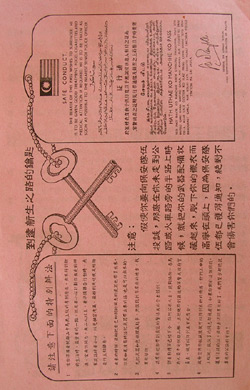 |
No. 1567, Safe Conduct
(Illustration courtesy of Bill Ashby)
Leaflet 1567 depicts a starving guerrilla in the jungle at the upper left on a pinkish paper. Text to the right is in the three major languages of Malaya. The back depicts a pair of 'keys to a new life' and a flag of Malaya. The English-language text is:
SAFE CONDUCT
THE BEARER OF THIS PASS WISHES TO SURRENDER. HE
IS TO BE GIVEN GOOD TREATMENT, FOOD, CIGARETTES AND
MEDICAL ATTENTION IF REQUIRED. HE IS TO BE TAKEN AS
SOON AS POSSIBLE TO THE NEAREST SENIOR POLICE OFFICER.
Some of the Chinese language text to the left, right, and below the keys is:
PLEASE PAY ATTENTION TO THE FOLLOWING SPECIAL PROCEDURES
1. When you are ready to leave the restriction and oppression of the Communist Party of Malaya in the mountains and come out to a new life, the most important thing is to carefully plan your method of escape. If two members, or two or more, are ready to act together, everyone must speak carefully in order not to disclose their escape plan. At best, use secret talk and code to communicate with each other.
2. When you are ready to leave it is best to bring out all of your weapons. But, if you have no way to bring the weapons out, you are still welcome to come out without them.
3. Hide your weapons and sacks first, then run to a place with a lot of people. Ask the public for help.
4. Ask the public to bring you to the nearest police base or army barracks to report.
5. General Templer has ordered that members of the public who are willing to help a member of the Communist Party of Malaya leave the mountain area and bring him or her to the nearest army, police, or government officer, will be rewarded with $500.
6. The government has announced that after you have crossed over, you will be treated well. According to the high level Communist cadre in the mountains, members who cross over will be abused. If you have any doubt about this question, please go and ask the public. Let both sides listen to the public.
THE KEY TO A NEW LIFE
Attention:
If you want surrender to the peace keeping forces, when you walk half way to the public road or by the railway track, hide your weapons, take off your shirt and raise it high above your head. The peace keeping forces have acknowledged that they will definitely not harm you.
WAY PASS
The bearer of this pass is willing to cross over and should be treated well, given food, drink, cigarettes, and if in need, medication assistance. As soon as possible bring him to meet with the closest high ranking police officer.
Some of the text to the right and below the starving terrorist is:
A LETTER TO ALL MALAYAN COMMUNIST PARTY FARMING PRODUCTION TEAM MEMBERS IN THE MOUNTRAINS
Important things that you should remember
Your farm in the mountains can only be a secret for a short time. Sooner or later we will find it and destroy it.
If you all are still cultivating, we will be coming to destroy your farm.
The Peace Keeping Force need not rely on the farms to have food. They have the ability to march and camp anywhere because they have good and sufficient food delivered by aircraft.
CAN YOU ANSWER THESE QUESTIONS?
Is there anything worse than your own working environment? Those rubber tappers, loggers, farmers in civilized areas, and shopkeepers, etc. Is their life better or worse than yours?
Do you believer you are on the winning side? Can you be sure that you will not die due to disease or injury, or being shot to death by the Peace Keeping Force?
Every time that you dig with a hoe or use your Parang blade on a tree, please ask yourself: "Am I just wasting my time and effort? When will the Peace Keeping Force pay us a visit? Will we able to harvest the crops that we have labored over?"
Even if you are able to harvest the crop, will you all be able to enjoy it? Or, will you be forced to tighten your pants belt, ration the food, or take the hard-earned harvest to the high ranking Communist cadres or other members that will benefit from it without having worked for it.
WHAT ARE THE WAYS TO END THIS SUFFERING?
Commit suicide by hanging yourself, drowning yourself, or shooting yourself? No!
Tell all your complaints to the Party cadre or leaders? No!
Follow the "Liberate the Public" party network? Yes! You are part of the public, thus you can liberate yourself!
HOW TO LIBERATE YOURSELF?
When you have the chance to sneak out, run to the public road or to a farming village. Ask the first person you meet to take you to the nearest Police or Army personnel. This is the best way. Quickly take the first chance that you can to get out! You might regret it if you wait too long.
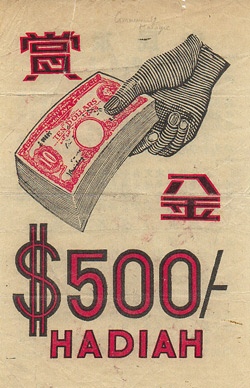
No. 1658C - $500 Reward
Leaflet 1658C depicts a hand holding a stack of the red 1 July 1941 "Board of Commissioners and Currency" $10 bills that were in use in Malaya before the Japanese occupation. The same image was apparently used on wrapping paper. This use of propaganda on items other than leaflets would be used again in Vietnam when the Americans would print Chieu Hoi ("Open Arms") surrender messages on shopping bags. The leaflet text is:
$500 Reward
The text on the back is:
Public Announcement Notice
Reward for Assisting Communist Terrorists to Surrender
The Federation of Malaya High Commissioner General Templer has made the following statement:
The number of youths who joined the Malayan Communist Party guerrilla organisation, and now recognise the MCP's lies and deceit and have surrendered to the government is increasing daily. However, there are still many who are in the jungle but want to come out to surrender to the Security Forces and start a new life.
The government encourages those youths to surrender to the authorities and atone for their crimes by loyally serving the nation rather than remaining in the jungle to die.
The government has decided that starting January 1st of this year, members of the public that assist an awakened youth to escape from the clutches of the Malayan Communist Party and bring him or her to surrender at a police station will receive a $500 reward. If more than one of you provides the assistance, the reward will be shared equally.
Please Pass this Information on to Others
To members of Malayan Communist Party:
This guarantees your safety when you surrender!
In order to ensure your safety in escaping from the jungle, the Federal Malayan Government will present a "Five Hundred Dollars Reward" to any member of the public that has assisted your surrender to the authorities.
Please carefully hide this leaflet on your person and when you surrender, hand it to a member of the public so that he or she can take you to the nearest Military or Police personnel.
If more than one person helps you, then they will all be able to share the reward among themselves.
No. 1828, Receive one thousand dollars reward to start a new life
(Illustration courtesy of Benjamin Seet)
Leaflet 1828 is a red reward leaflet depicting a Bren machine gun and reminding the terrorist that rewards are paid for weapons, as well as defections. Some of the text is:
$1,000/=
If any member of the Malayan Communist Party is able to leave the jungle and bring out a Bren gun, or able to lead the Peace Keeping Forces to unearth a hidden Bren gun that he or she knows about, he will be eligible for a $1000 reward.
RECEIVE $1000 REWARD TO START A NEW LIFE!
Notice the different color of the leaflets that we illustrate. The color was carefully selected to either match or to stand out against the jungle background. C. C. Too's deep understanding of the enemy mind set allowed him to craft highly effective propaganda leaflets. He ensured that leaflets were produced in colors like red, yellow and orange to match the light yellow sand and deep brown earth near streams and rivers. Other leaflets were of dull colors like grey, blue and green. This was because terrorists thinking of surrendering would not dare pick up bright leaflets for fear of being caught by their leaders, and would only risk picking up the less obvious ones.
Too Chee Chew is mentioned in The War of the Running Dogs:
Too would tell his staff: Don't preach. Don't theorize. Never say "I told you so." No propaganda based on hatred. One of Too's favorite lines was "You are a human being and we all make mistakes."
Leaflet No. 1750, 'Qualifications of a High Ranking Leader'
(Illustration courtesy of Lee Richards)
Leaflet No. 1750 depicts caricatures of a Communist leader on the front and a Communist fighter on the back. The leader has a ferocious face, the fighter big ears and a very thin waist. The text is:
QUALIFICATIONS OF A HIGH RANKING LEADER
1. Big eyes: able to supervise all the movement of his subordinates.
2. Small ears: so that will not be able to listen to the complaints and protests of subordinates.
3. Big mouth: to use for issuing orders the whole day long, telling lies about peace and equality, and to eat and drink voraciously
4. Small chest: to reduce his chance of being a target and, to avoid being shot by guns and bullets.
5. Big stomach: in order to have the capacity for good food and precious health supplements.
6. Slim little hands: convenient to loosen tight belt
7. Big buttocks: For just sitting all day long doing nothing while the comrades laboriously work the whole day carrying food supplies and collecting donations.
QUALIFICATIONS OF A MODEL FIGHTER
1. Blind Eyes: so that he won't be able to see his higher ranking leader's mistakes and bad habits.
2. Big Ears: to hear a whole bunch of propaganda and lies and to obey unreasonable orders.
3. No Mouth: so that he can't gossip secretly or be able to eat.
4. Big chest: in order to block gun shots to protect his superior.
5. Small stomach: to help lower food consumption, and to solve the problem of food shortages.
6. Rough hands: in order to do rough work.
7. Big feet: in order to walk up and down the jungle and streams.
No. 3006, TO ALL COURIERS
(Illustration courtesy of Benjamin Seet)
Communist couriers would run through the jungle carrying small messages from one group to another or from a leader to the troops in the field. This leaflet shows the hand of a courier holding several such small slips of paper. The text is:
How much reward cash will the Government pay me for the letters I am carrying?
The back is all text:
TO ALL COURIERS
Any member of the Malayan Communist Party can surrender himself at any time and start a new life. You may already know this, but did you know about the special offer to couriers?
All couriers of the MCP are especially welcomed and from today those couriers who surrender and bring in the documents they are carrying are to be given a cash reward which will be assessed by the value of the information contained in the documents and the value of the information carried by the couriers in their head.
Remember as you walk the jungle risking death for a useless and lost cause - Those rolled up slips which you are carrying may be worth a ransom price!
Safe Conduct Pass
(Illustration courtesy of Baz Ford)
This safe conduct pass is all text, on green paper, and written in all the languages of Malaya. The English language portion of the text is:
THE BEARER OF THIS SAFE CONDUCT PASS WISHES TO LEAVE THE JUNGLE.
TAKE HIM TO YOUR OFFICER.
Safe Conduct Pass
(Illustration courtesy of Baz Ford)
This third safe conduct pass is similar to those above, all text, on cream-colored paper, and written in all the languages of Malaya. The English language portion of the text is:
THE BEARER OF THIS SAFE CONDUCT PASS WISHES TO LEAVE THE JUNGLE.
TAKE HIM TO YOUR OFFICER.
No. 1288, SAFE CONDUCT
(Illustration courtesy of Roy Follows)
One of the more interesting safe conduct passes bears the flag of Malaya at the top. As always, the text is in all of the languages of Malaya and says:
SAFE CONDUCT
The bearer of this pass wishes to surrender. He is to be given good treatment, food, cigarettes, and medical attention, if required. He is to be taken as soon as possible to the nearest police officer.
The back of the leaflet depicts five surrendered Malayan Communists at the top and a fisherman with a net and a great haul of fish in the center. Each of the fish is marked with the title "unknown person," indicating that the British have the corpse but do not know the name of the dead terrorist. The text is:
1. Liu Mu 2. Yao Yi Cheng 3. Huang Shen 4. Hassan Bidin 5. Zheng Min
The Security Forces set up an ambush and the death toll rose from 12 to 27 people. Those killed will no longer enjoy a happy life. This is just the total as of 16 July 1952. It will continue to rise.
Those devils that have been shot dead and have "Unknown Person" written on them, were brought down from the mountains but we have no way to identify them. If you want to know who they are, you can go to the place where they are laid out to see their rotting bodies.
To those that still stay in the jungles and wonder about staying or coming out, you still have a chance to choose your own destiny. You can wait to fall into a trap by the Security Forces and die, or leave Communism and its viciousness immediately and come out and join the happy people pictured above.
WE TAKE THIS OPPORTUNITY TO THANK THE PEOPLE OF EASTERN PAHANG FOR THEIR ASSISTANCE IN MAKING THIS ANTI-COMMUNIST BATTLE SUCH A GREAT SUCCESS!
3133/HPWS/2, YOUR LIFE IS YOUR PROPERTY
(Illustration courtesy of Benjamin Seet)
Leaflet 3133/HPWS/2 was printed in April 1954 on a bright red paper that would easily stand out against the jungle greenery. It depicts a cartoon terrorist in shock at the thought of being ambushed by two government soldiers. There is no text on the front. Text on the back is:
YOUR LIFE IS YOUR PROPERTY
Waste your life by staying in the jungle or -
Save you life by escaping from the jungle.
The cause is useless. The struggle is lost.
You have no firm bases.
You have no outside help.
The leaders say you must sacrifice your life.
Are you willing to sacrifice your life?
Why is this leaflet dropped in this particular spot?
It has been dropped as a warning to you because here in
This area one of your comrades lost his life.
Do you know him personally?
The choice between death and a new life is yours.
Choose wisely.
3134/HPWS/3, WHAT WEAPONS DO YOU CARRY?
(Illustration courtesy of Benjamin Seet)
Leaflet 3134/HPWS/3 depicts three caricatured terrorists discarding their identification and their weapons as they attempt to flee. Text on the back is:
WHAT WEAPONS DO YOU CARRY?
Comrades, we have already offered all of you a new way of life.
Transport members and sentries are especially welcome. To all those leaders endowed with courage, who were able to bring their men out of the jungle so as to save their lives, we have given special rewards.
We have heard stories of some leaders who have not only used threats to prevent their men from fleeing the jungle, but have actually put to death, cold-bloodedly, those men attempting to do so.
Under such circumstances our security troops will take steps to eliminate those leaders. The security troops are fully aware that the leaders normally carry pistols or carbines and in this case - our being in combat - those carrying such weapons will be the first targets of our shooting.
In short, what you have been warned of is this: you must never carry your leader's pistol or carbine, because you will attract special and dangerous attention to yourself if you do so. This will certainly enable your leaders to indulge further in their dangerous activities.
This is similar to American officers during the Vietnam War who did not wear their 'brass' in combat, told their radioman not to stay too close, and ordered their men not to salute them in an attempt to confuse Viet Cong snipers who would attempt to kill any officers that they identified.
3161/HPWS/6
(Illustration courtesy of Benjamin Seet)
This leaflet has five boxes for the photographs of communist terrorists on the front and five more on the back. On the front, the first, second and fourth boxes depict the photographs of actual terrorists. The third and fifth boxes have a caricature of a terrorist without a face.
The British soldier who found the leaflet has written in ink on the front:
If you see any CTs*, give them one each.
All these are big CTs who have been shot.
Then leaflets are dropped on the jungle.
* Communist terrorists
On the back of the leaflet the five actual photographs are in boxes two through four while the caricatures appear in one and five.
3211/HPWS/18, Searchlight Leads You to the Road of Escape
(Illustration courtesy of Lee Richards)
Leaflet 3211/HPWS/18 was printed about 1954 and depicts three guerillas discussing a searchlight in the distance. The text on the back is:
SEARCH LIGHT LEADS YOU TO THE ROAD OF ESCAPE
Look for the bright ray of the searchlight in the night sky. The searchlight is shining from the road.
If you want to escape from the forest to start a bright new life then run in the direction of the light to reach the road. The road will take you to a brand new happy and peaceful living environment.
Before you reach the road, please hide your weapons and ammunition. Then run to the road, raise both your hands high above your head and try to stop the first car that passes by.
All military drivers have been ordered to help you, and at the same time, civilians that assist you will receive a cash award.
If you stay in the jungle you will definitely be either shot dead ravaged by disease and hunger. A lot of people have escaped from the jungle and saved their own lives. Don't you want to save your life? Sacrificing yourself for an unnecessary and losing battle is a stupid thing to do.
You will definitely not be abused and you will immediately receive good food and medical treatment.
Come and join the side where your friends have already begun a new life.
When I first saw this leaflet I was sure that I mentioned the searchlight program in this Malayan Emergency article. I could not find it. After a search through my other articles I discovered that I had mentioned a similar program in an article about the Chieu Hoi (Open Arms) program in Vietnam. It appears that just a few years later American forces in Vietnam copied the British program in an attempt to get the Viet Cong to rally to the national government. The Final Report Psychological Operations Studies - Vietnam says:
Operation Searchlight in Military Region I was designed to influence enemy soldiers to defect during the Tet truce period of 1970 - 1971. Giant searchlights would be aimed at the sky and the enemy urged to follow the beam to the searchlight where they could safely surrender. There is no record of any defectors rallying at any of the 22 searchlight sites.
Leaflet 7-697-70
The above leaflet was prepared by the 7th PSYOP Battalion for Operation Searchlight. It depicts a pair of searchlights aimed skyward and the Chieu Hoi Symbol. The text is:
During the cease fire period of Tan Hoi New Year, all United States, Vietnam, and other Allied bases will turn on their searchlight at night. The searchlight will help you to find freedom. Move toward the direction of light, hide your weapon and wait until the daylight to rally. When getting close to the Government of Vietnam or Allied units, shout aloud "CHIEU HOI." You will be welcomes and receive good treatment. Guide the Government of Vietnam or Allied forces to recover your weapon for a reward.
MOVE TO THE SEARCHLIGHT
DO NOT LET YOURSELF GET KILLED IN THE DARK
3259/PK/9, To comrades of the 13th and 15th independent division
(Illustration courtesy of Lifeng Kuah)
Leaflet 3274/HPWS/29 text on the front reads:
TO COMRADES OF THE 13th AND 15th INDEPENDENT DIVISION
Chong Long Heng is your communication officer. He was shot dead by security forces on 31 March 1954.
Don't you feel strange about the fact that so many lower ranking comrades are shot dead, while higher ranking comrades attempt to save their own lives?
Please refer to the following facts:
These lower ranking comrades are dead:
| Ah Tim | Party Member | 31 Oct 1951 | Shot dead |
| Chee Kong | Party Member | 31 Oct 1951 | Shot dead |
| Xiao Ping | Party Member | Jan 1952 | Shot dead |
| Meng Fei | Party Member | 28 Mar 1952 | Shot dead |
| Lau Cai | Party Member | 28 Mar 1952 | Shot dead |
| Kuan Yew | Combatant | 17 Jul 1952 | Shot dead |
| Kuan Seng | Combatant | 17 Jul 1952 | Shot dead |
| Ah Chan | Min Yuen Personnel | 19 Jul 1952 | Shot dead |
| Ah Zhong | Combatant | 18 Jun 1952 | Shot dead |
| Weng Wah | Combatant | 18 Jun 1952 | Shot dead |
| Ah Soon | Combatant | 18 Sep 1952 | Shot dead |
| Choo Zai | Combatant | 18 Sep 1952 | Shot dead |
| Ah Kee | New Comrade | 24 Oct 1953 | Shot dead |
| Cheng Sin Di | Combatant | 28 Mar 1953 | Shot dead |
| Chong Kee Huat | Combatant | 23 Mar 1953 | Shot dead |
| Chong Long Heng | Communication Officer | 31 Mar 1953 | Shot dead |
| Lee Ngao | Combatant | 22 Apr 1954 | Shot dead |
| Chan See Chuen | Combatant | 22 Apr 1954 | Shot dead |
Comrades: Many are dead. Only a few managed to save themselves
These higher ranking leaders are still alive:
| Chong Mun | State Committee | | |
| Chen Keng Yew | Area Committee | | |
| Lau Fong | Area Committee | | |
| Chan Kong | Area Committee | | |
| Chow Cai | Area Committee | | |
| Yen Kian | Area Committee | | |
| Kit Ning | Branch Committee | | |
| Lee Yan | Branch Committee | | |
| Ma Chee Wah | Branch Committee | | |
| Lau Kiu | Branch Committee | | |
| Ah Lai | Branch Committee | | |
These Leaders are dead:
| Liao Ho | Branch Committee | 5 Jan 1953 | Shot dead |
| Ah Yen | Branch Committee | 24 Oct 1953 | Shot dead |
| Zhong Yun | Area Committee | Oct 1953 | Shot dead |
| Lee Siang | Area Committee | 24 Oct 1953 | Shot dead |
| Siao Niu | Team Leader | 22 Apr 1954 | Shot dead |
Leaders: Many managed to save themselves, only a few are dead.
Even though you all manage to survive, but your life is unnecessarily slipping away. You all are getting older – before you all get old, how much time do you think you'll have for a stable life?
If you all wish to start a new life, you can leave the jungle any time.
Reward:
If you bring out a Bren gun, you will be received a reward of $1,000.
If you bring out five other comrades, you will receive a reward of $2,500.
Exceeding five, you can get an additional $500 reward for each comrade.
If you are a communications officer and you bring out documents you will get a reward.
If you have any information on operations that help to capture guerrillas or particularly that lead to the elimination of a leader, you will definitely receive a large reward.
BETTER OPPORTUNITIES LIE OUTSIDE THE JUNGLE!!
| 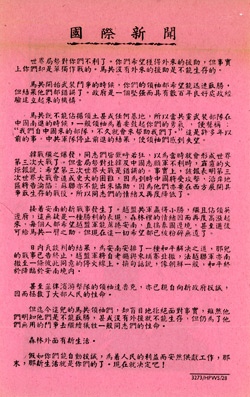 |
3273/HPWS/28, International News
(Illustration courtesy of Lee Richards)
INTERNATIONAL NEWS
The world situation is against you. You hope for outside help but you fight alone. The MCP cannot survive without outside aid. At the start of the Malayan Communist Armed Struggle your leaders hoped for quick victory, but they were wrong. The Government is tough and well established with hundreds of years experience behind it. The MCP failed to capture territory or even bases, so as the Communist Armed Forces marched southwards in China the leaders bolstered your courage by saying, "Soon our army from China will come to help us." That was many years ago. The Chinese Communist Army stopped and the leaders were in despair. Then the Korean War broke out and the comrades cheered. Now there would be a third World War. When the situation was going against the North Koreans and China Volunteers, the Torch Press in Berak said that it was wrong to hope for a third World War. In fact, the paper stated that a third World War would cause even greater hardship as China would be invaded and the coastal areas lost; that Russia would not be able to help because they would be fighting a battle for survival in the West. So once again the spirits of the comrades dropped low. Then came the new Indo-China battles. The Communist Vietminh won some minor battles and then captured Fort Dien Bien Phu. This no doubt was a victory and once again hopes in the jungle soared high. Everyone hoped that the Vietminh Army would sweep through Indo-China and on to the borders of Thailand and perhaps later send aid to help the MCP. But now those hopes are dashed to the ground. By negotiations in Geneva, a peaceful settlement has been arranged in Indo-China. The fighting has stopped. The Vietminh will withdraw from Laos and Cambodia and the French Union Forces will withdraw south to an agreed truce line. In other words, like Korea, peace has come to Indo-China. Even Luis Taruc, the leader of the Philippine guerrillas, has surrendered himself to the new Government, thereby saving the lives of a great number of people. Yet here in Malaya the MCP leaders blindly refuse to face facts. Despite their knowledge that they cannot win or even survive without outside aid they continue to sacrifice the lives of the comrades for their useless cause. There is a new life outside the jungle. That new life is yours if you voluntarily surrender and offer to work in peace for the benefit of the people. Decide now.
| 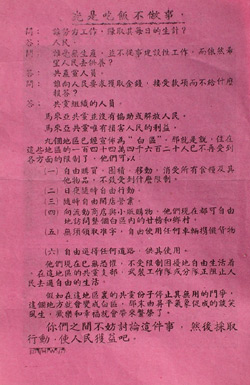 |
3274/HPWS/29, White vs. Black Areas
(Illustration courtesy of Bill Ashby)
Leaflet 3274/HPWS/29 is in the form of a six-panel cartoon depicting scenes of the Communist free "White Areas" at the left compared against those "Black Areas" that are still under Communist control or known to contain Communists and thus are suffering sanctions. The text is:
THERE ARE AREAS THAT ARE NOT YET WHITE AREAS, AND THE COMMUNIST PARTY IS TO BLAME.
The upper right cartoon shows an empty street with just a dog outside.
In the Black Area, curfew is imposed continuously.
The upper left cartoon shows happy people in the streets:
In the White Areas there is no curfew imposed.
Guards are shown searching two men in the middle right panel.
In the Black Areas, you are not allowed to bring food to work in order to avoid food falling into the hands of the gangsters.
In the middle left panel three men carry their food to work.
In the White Areas, you can bring food to work at the farm, forest, or rubber estate.
In the bottom right panel a man is searched before allowed to pass through the barbed wire. There is a sign that says "Stop - Check point," and the text:
In the Black Areas the checking of identity cards and food packages is continuing.
The final box at the lower left depicts a happy man carrying a bag waving to another on a food-laden bicycle. The "Stop - Check point" sign has been crossed out with a big "X." The final text is:
In the White Areas, you can move around freely, and need not go through check points.
The back of the leaflet is all text:
JUST EAT RICE WITHOUT DOING ANYTHING
Question: Who works hard every day to earn a living?
Answer: The people
Question: Who is not productive, and does nothing constructive, but still expects the people to support them?
Answer: Members of the Communist Party
Question: Who asks for money from the people, accepts the contributions, but gives nothing in return?
Answer: Members of the Communist Party Organization.
The Malayan Communist Party did not support or liberate the people.
The Malayan Communist Party only destroys the benefits of the people.
Nine areas have been declared as "White areas." That is to say, the 1,444,620 people living in these areas no longer are restricted in any way.
(1) They can purchase freely, stockpile food, move around, and consume all the food supplies and other items without any restriction.
(2) They are free to move around day and night.
(3) They are free to open their shops at any time for business.
(4) They can purchase from shops-on-wheels and hawkers. They can now visit the other villages within the whole White Area.
(5) They need not apply for permits and are free to use any vehicle to carry goods.
(6) They are free to travel on any road.
They no longer live in fear now, living freely without restriction.
In some areas the armed personnel and sub-divisions of the Communist Party are trying to stop the people from having a free life.
If the members of the Communist Party in this area will stop their useless fighting, this area will become a White Area. Then, under a peaceful environment, it will change into a place of joy and happiness and there will be prosperity for all.
WHY DON'T YOU DISCUSS THIS MATTER AMONG YOURSELVES, THEN TAKE ACTION THAT BENEFITS THE PEOPLE
| 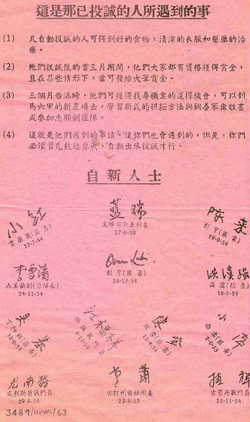 |
3489/HPWS/63, Regardless of how your leaders lied to you previously...
(Illustration courtesy of Rufus Cole)
This leaflet signed by Lieutenant General Sir G. K. Bourne, (Director of Operations 1954/56) tells the guerrilla how to surrender, what he will receive when surrendering, rewards for weapons turned in, offers of help in returning to the government, and the promise of repatriation to China for those who wish it. The text is:
1) Regardless of how your leaders lied to you previously, preventing you and your friends from leaving the jungle, facts are, there are no less than 1,341 members giving up communism based on the conditions laid down by the government in September 1949 that they will be fairly treated and will not be tortured after giving up communism.
2) Since September 1949, none of those who willingly surrendered have received any ill treatment. Quite the opposite, they are part of society today and have found themselves a job. Reunited with their family members and enjoying their new lifestyle.
3) The Government will not give up fighting communism. If you stay put in the jungle, you will sooner or later die of hunger or sickness.
4) Since the end of the Vietnam War, you are the only communist organization we are fighting against. You will not receive any foreign aid.
5) Make a decision now, give up communism together with your friends or give up communism yourself before it is too late.
The British would occasionally publish the name of dead or surrendered terrorists in an attempt to demoralize the guerrilla fighters in the jungle. On the back of leaflet 3489/HPWS/63 they have identified thirteen fighters who defected to the government between 1950 and 1954. The text is:
These are the things they experienced after they gave up communism:
1) Good food, clean clothes and medical treatment.
2) Within the first three months, they received financial aid. Depending on circumstances, some of them may receive more financial aid than others.
3) After a three month period, they can seek employment. They can learn modern farming techniques in Melaka.
4) This is what they experienced; you too can experience it yourself. However, you must first surrender.
Signatures of those who have given up communism.
3666/HPWS/82, WHO IS THIS PERSON?
(Illustration courtesy of Bill Ashby)
Leaflet 3666/HPWS/82 depicts the face of a high-ranking Party leader and the following text:
WHO IS THIS PERSON?
He is your "OVERLORD!"
He is the Malayan Communist Party Secretary General CHIN PENG!
He is the culprit that started the bloody arms battle.
HAVE YOU SEEN HIM BEFORE?
Did you vote for him and his Central Committee to be your leader?
Then why must you blindly follow Chin Peng and his single handed control of the Central Committee of the Malayan Communist party?
The reverse side continues:
WHAT ARE YOU ALL FIGHTING FOR?
FOR THE "LIBERATED AREA?"
Where is your liberated area?
In contrast, the number of Federation of Malaya citizens living in the 'white areas' is increasing. The inhabitants in these "white areas" have by their own effort, released themselves from the terror and harassment of the MCP.
In Eastern Pahang and Northern Pahang the MCP local area Committee Groups have collapsed and are non-existent.
Currently about 1600 comrades have determined to release themselves from being controlled by the MCP, and are on their way to a new life.
FOR "DEMOCRACY?"
Within the party, did you really vote for your high ranking superiors?
In contrast, the citizens of the Federation of Malaya will be having their free general election on 27 July, using secret ballots to choose the people's favorite leader, and to form a new government.
If you had not been deceived by the MCP to go to the mountains, you would be actively participating openly in legal politics now, doing what's best for the people, or even possibly becoming the people's elected leader.
In the mountains, do you have secret ballot to vote for your so-called Central Committee leader?
Do you even know your Central Committee members, or your State Committee or Local Committee members?
FOR "AUTONOMOUS GOVERNING BODY?"
In the mountains, do you have any "autonomous governing body" facility?
In contrast, the MCP is attempting to interfere with the people's use of a peaceful means to achieve an "autonomous governing body."
The MCP fears that the entire population will have an election that is free and with secret a ballot.
In fact, this free democratic election does not require the help of the MCP, not ignores the objection and interference of the MCP.
It is now being actively carried out, and using concrete means to achieve the target of a real and democratic "autonomous governing body"
FOR "THE BENEFIT OF THE GENERAL PUBLIC?"
Do you really battle for the benefits of the people?
What actually did the MCP do for the benefit of the general population of Federation of Malaya?
The MCP threatened the good people, collected monthly donations from the public, killed people, destroyed the people's means of livelihood, wrecked the people's peaceful life, and interfered with the development of freedom and democracy.
Do these actions benefit the people?
Does the public really support you?
If your activity is beneficial to the people, then it will not be hated and rejected by the people, causing you to be separated and isolated from the public.
HOW LONG DO YOU REALLY WANT TO CONTINUE THIS BLOODY SACRIFICE?
Your so-called "Battle Aim?" In fact, under the peaceful cooperation of all the citizens of Malaya, without any help from you, and without your interference, we are gradually realizing our aim. Ask yourself frankly:
WHAT IS IT THAT YOU ARE REALLY FIGHTING FOR?
3802/99/B
(Illustration courtesy of Benjamin Seet)
I have selected this leaflet to depict because of the use of two signatures at the bottom. The use of the twin signatures was mentioned in theStraits Times of 13 September 1955 in a short blurb entitled, "Now Rahman Signs it too." It says:
NEW amnesty leaflets have been printed and are being dropped in the Federation. They carry the signatures of both the Director of Operations, Lt. General Sir Geoffrey Bourne, and the Chief Minister, Tengku Abdul Rahman. Previous leaflets carried only the signature of General Bourne.
3814/PK/88/C/VIII, SAFE CONDUCT PASS FOR PEACE
(Illustration courtesy of Bill Ashby)
SAFE CONDUCT PASS FOR PEACE
The bearer desires to cease the armed struggle. He is not to be ill treated. Help him to reach the nearest Government Official as quickly as possible. Anyone who assists him will be well rewarded.
The text on the back states:
WHITE AREA
The elected government of Federation of Malaya has announced an amnesty offer.
Under the amnesty, you can leave the jungle safely and smoothly to begin a new life.
Among all of you that are willing to cross over, if you committed any crimes during the period of emergency under the command of the Communist Party, prior to the official announcement of the amnesty offer, regarding those crimes, you will not be prosecuted by the Government. You will be pardoned.
If you did not know about the announcement of the amnesty offer, and under the command of the Communist Party, committed any crimes regarding the emergency, those crimes will not be prosecuted by the authority. You will be pardoned.
The government has designated a few 'White Areas' in order for you all to leave the jungle and come out to a safe territory.
Within these white areas, the Security Forces have been ordered by Lieutenant General Bourne to withdraw, thus you need have no fear of being attacked or fired upon. (Of Course, you all can simply cross over in any area or to any person, but at in those areas you might not be safe.)
Don't delay, come to white area immediately
KEROH AREA
1. White Area: Area within two miles radius, around Simpang Pasir near to Kelian Itan - Gerik Road.
Cross Over Area: You can go to Simpang Pasir to meet with anyone
2. White Area : near to Keroh - Kelian Intan road, 128 1/2 miles east, part of Padang Chong restricted mountain.
Cross over Area : You can go to Zaazr (a tin mining activity) 5 acre vacant land to meet with anyone.
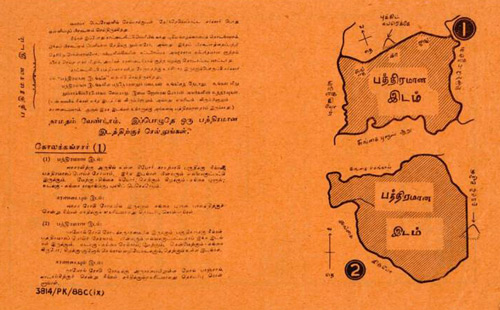 |
3814/PK/88C(ix), SAFE CONDUCT PASS FOR PEACE
A rather crudely printed leaflet on bright orange paper serves as a safe conduct pass in Chinese, English, Malay and Tamil and says on the front:
SAFE CONDUCT PASS FOR PEACE
The bearer desires to cease the armed struggle. He is not to be ill treated.
Help him to reach the nearest Government Official as quickly as possible.
Anyone who assists him will be well rewarded.
It is signed by the "Director of Operations, Federation of Malaya."
The back of the leaflet depicts two maps and a long propaganda text. Some of the message is:
The popularly elected Government of the federation of Malaya has declared an amnesty.
You may now leave the jungle and begin a new life. Those of you who come in and surrender will not be prosecuted for any offence, connected with the Emergency, which you have committed under communist direction, either before this date or in ignorance of this declaration.
The Government has made certain "SAFE AREAS" to help you leave the jungle and reach safety.
IN THE SAFE AREAS NO SECURITY FORCES WILL HUNT YOU OR SHOOT AT YOU. THESE ARE GENERAL BOURNE'S ORDERS.
A second message to the left of the maps describes two of the safety zones. The first direction is:
You will be safe in that part of the Chior Forest Reserve near Losah which lies with the following boundaries:
West – The Sungei Chior.
South and East – The Sungei Plus
North – the Sungei Kajang and Bukit Berekeh.
Go to the Sungei Plus Bridge at the end of the Lesah Road and contact anyone you see….
4104/KDH/71, Death is Drawing Closer
(Illustration courtesy of Bill Ashby)
Leaflet 4104/KDH/71 is all text with on a bright red-pink paper. The text on the front is:
Death is drawing closer,
Rescue yourself quickly before it's too late!
Liberate yourself from the useless war!
Leave immediately and step out on the road to a new life!!
The back of the leaflet is also all text:
A MESSAGE TO: AH TU, AH XIANG, HUANG TIAN BIAO, HUANG LE SHENG, ZHI XIONG, GUO RONG, AH SHENG, DA MU
This leaflet is an opportunity for you all to step out on the road of a new life.
There is a comrade among you that was injured during the battle with Security Forces.
You are lucky that you escaped. But think: Will you always be so lucky?
The Security forces are constantly searching, pursuing and attacking you.
If you delay and procrastinate for even an hour you may suffer from unnecessary pain and danger.
Will you be so lucky the next time that you meet the Security Forces?
Who among you will be the next to suffer from the pain of a wound?
Who among you will end up badly like Ah Shang and Chee Rong?
Why must you listen to the orders of superiors and sacrifice your precious life?
Those superiors are afraid to die, and never take any risks!
Do you know that because of your activities, the public has suffered all kinds of restrictions for the past 8 years of the Emergency.
Why don't you learn from the intelligent examples of Xiao San and Tek Seng and immediately get out on the road to a new life?
You will have good medical care waiting for you here!
You will be given fair treatment by the government and you can meet up with your friends and relatives once again.
You will be on the road to a peaceful and happy new life.
RETREAT FROM THE EDGE OF DEATH! COME OUT QUICKLY AND MAKE A FRESH START. YOU WILL REGRET IT WHEN IT'S TOO LATE. A GREAT NEW LIFE IS WAITING FOR YOU TO ENJOY WHEN YOU LEAVE THE JUNGLE!
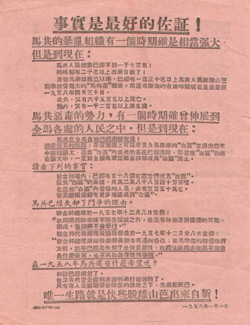 |
4809/HPWS/182, Expansion of the White Areas.
(Illustration courtesy of Norman Doctor)
As the British cleared an area of terrorists they declared it a "White Area." These white areas received special privileges such as increased permission for movement and shortened hours of curfew. In this leaflet the British are pointing out to the terrorists how they are gradually losing control of the peninsula.
The British used strict curfews and tight control of food supplies to force compliance from rebellious areas and flush out guerillas. Crops grown by the Communists in response to these measures were sprayed with herbicide. These restrictions would be lifted on the White Areas which had been found to be free of Communist incursion, yet another incentive for the population to turn in the rebels. The title of the leaflet is:
FEDERATION OF MALAYA "WHITE AREA" YEARLY GRADUAL EXPANSION DIAGRAM
The four maps show a gradual expansion of the white area. Each Malayan state is listed on the leaflet and it gives the date above each map:
31 December 1954
31 December 1955
31 December 1956
31 December 1957
Boxes at the bottom of the map show the white and black colors and the explanation:
White Area, Area that is not declared White Area, Border line of White area, Country Border Line, and State Border Line.
The back of the leaflet is all text:
FACTS ARE THE BEST EVIDENCE!
The Malayan Communist Party's attack forces were once really strong, but now:
The Total MCP membership is not even 1,700!
At the same time, more than 2,000 people have turned over a new leaf.
Since the independence of Malaya, more than 130 MCP members left the jungle to accept the lenient amnesty offer, and the validity period of this amnesty offer has been extended until 30 April 1958.
There were more than 6,500 Communist fighters killed.
In addition, there were more than 1,200 Communists captured alive.
The vicious influence of the MCP was present to all the people everywhere in Malaya at one time, but now:
The MCP at various places in Malaya has continuously retreated in defeat!
Please refer to the map on the back! As you can see from the map, the "White Areas" have continuously expanded at various places in Malaya over the past four years.
Within these "White Areas," the MCP attack forces have been eliminated, plus these "White Areas" are still being expanded until the whole Federation of Malaya becomes a "White Area."
Please look at the following facts:
Within the territory of the Federation, 48 areas have been declared as "White Areas."
The area of the "White Area", is equal to 28,840 square miles.
The population of the "White Areas" is 3.5 million people.
There are more places that are about to become "White Areas."
The MCP has lost any reason to fight on
The Federal Prime Minister announced on 8 December 1957:
"The government believes that unless Chin Peng willingly surrenders, it is impossible to reach an agreement. Thus, there will be no dialogue."
The Acting Federal Prime Minister and National Security Minister announced on 28 December 1957:
"The Federal Prime Minister Tunku Abdul Rahman ordered me to tell everyone that in the opinion of the Federal Government of Malaya, Chin Peng has already lost all his importance, and the government will no longer consider him as anyone of importance and will not contact him in any way."
After 1958, what hope does the MCP have?
The Peace talks are already hopeless.
There is no hope that an attempt to use dialogue will solve the crisis.
There is only death under the attack of the people-supported Peace Keeping Forces.
THE ONLY ROAD TO SURVIVAL IS TO QUICKLY GET OUT OF THE JUNGLE, AND COME OUT TO TURN OVER A NEW LEAF
4997/PK/355, Dear Comrade Pak Yuen
(Illustration courtesy of Benjamin Seet)
Tactical leaflet 4997/PK/355 was prepared on a dull red paper and depicts three Malayans; the former terrorists Si Yuen and Kwai Mui, along with the mother of the terrorist Pak Yuen, still hiding in the jungle. The text is:
Dear Comrade Pak Yuen,
It has been many days since I came out with Kwai Mui. We are leading a normal life now with the assistance of the government.
Although we have left the dark jungle, we are still thinking about you and Choo Chai. You know that Choo Chai will shortly give birth to her first baby. You have no hospital or medicine in the jungle, and worse, you are young and have no medical experience. There is cause for concern about Choo Chai and the birth of her baby.
I visited your mother on the 20th along with Kwai Mui and told her about your condition. She is still doing well but she worries about your safety and your future.
I want you to give some thought to your condition and your future. In the absence of any armed assistance, your struggle is hopeless and senseless. What good does it do for you to remain in the jungle? Are you waiting to be killed?
I can tell you in all honesty that the Government is determined to end the Emergency by the use of force. It will continue to deny you food and send more Security Forces to search for you. As I see it, you have no future in the jungle. You have to come out while the Government's amnesty offer is still on the table so that you don't waste your life uselessly. When you come out you will regain freedom of movement and financial assistance and the government will not look into your past deeds in the jungle. I hope that you will immediately leave the fearful jungle and come out and start on the path to a new life.
I hope to see you soon,
Si Yuen
22 May 1958
YOU TOO CAN ENJOY WELL EQUIPPED HOSPITAL FACILITIES
(Illustration courtesy of Baz Ford)
This leaflet shows an attractive Malayan woman in a hospital bed. The text is:
This is Ya Xiang who has received good medical treatment in hospital. When she left the jungle on 13th July 1956, she was severely injured. But now, she has been treated and has fully recovered. There is no need for her to suffer. She can live a new happy life, she need not be concerned about the danger in the jungle.
Other leaflets used similar themes. For instance, a special message to the pregnant terrorist Lim Yook Kee showed a picture of a baby in a hospital bed. The text was:
How safe and comfortable is this baby in a government maternity hospital? Congratulations on your pregnancy. For your own safety and that of your new baby, come out at once and self-renew and have your child delivered safely in a government maternity hospital.
S.N. 34, "Fen Dou Bao" Newspaper Leaflet, Issue 34
(Illustration courtesy of Bill Ashby)
The propaganda newspaper Fen Dou Bao was published in Kuala Lumpur and disseminated on a regular basis to the news-hungry terrorists in the jungle. The title can best be described as "Striving for a better life" so for the purposes of this article we will use the term proposed by our translator and call it "The Striving Newspaper." Newspaper S.N.34 has five major stories on the front page. They cover such subjects as a discussion of the status of Asia by the Premier of Ceylon; the "Colombo" plan's progress due to the cooperation of all the local nations; a self defense group that suppressed a riot; the cooperation between the employers and the workers in Great Britain; and an atomic program implemented by the United Nations.
Page two has a number of smaller articles, including news from the various states of the Federation; the continued suppression of the insurgents; a message encouraging the Communists to surrender; a discussion of the food shortages among the terrorists; and a story about an attack on children that was driven away by the arrival of the police.
Barber mentions the newspaper leaflets:
Too knew that many CTs who had spent months in the jungle were so starved of news that they would be unable to resist picking up a leaflet which dealt only with hard facts, so he produced a monthly news sheet with photos of CT casualties, names of surrendered CTs, and the mistresses of high-ranking officers, for the rank-and-file greatly resented this privilege.
S.N. 65, "Fen Dou Bao" Newspaper Leaflet,
Issue 65, 31 July 1956
(Illustration courtesy of Baz Ford)
This leaflet in the form of a miniature newspaper coded S.N.65 features a cartoon of a terrorist in the form of a skeleton in ragged clothes walking toward 1957 with the question "How far can you go?" and the number of dead for each previous year. The newspaper is dated 31 July 1956. Some of the articles discuss news from the various states of the Federation and the continued suppression of the insurgents.
S.N. 77, "Fen Dou Bao" Newspaper Leaflet,
Issue 77, 31 July 1957
(Illustration courtesy of Baz Ford)
This leaflet in the form of a miniature newspaper coded S.N.77 features a cartoon of guerrillas in the jungle looking toward a happy prosperous Malaya. The newspaper is dated 31 July 1957. As in all the papers there is news of the various states such as Perak, Johor, and Selargor. There is a long article mentioning the names of all the Communists who have been killed during the month of July 1957. Another article states that the Malayan Communist Party cannot stop independence. And as always, the continued suppression of the insurgents.
S.N. 109, "Fen Dou Bao" Newspaper Leaflet,
Issue 109, 31 March 1960
(Illustration courtesy of Roy Follows)
This leaflet in the form of a miniature newspaper coded S.N.109 features a cartoon of starving ragged guerrillas looking at happy and healthy Malayans. The newspaper is dated 31 March 1960. One of the featured articles states that "the public utterly detests the Malayan Communist Party." Another article points out that the Communist Party in Ceylon lost a recent election and won only 4 seats out of 138. The status of the Malayan Communist Party is reported. 6,705 MCP members have been shot dead. 2,696 MCP members have come out to start a new life. 1,286 MCP members have been arrested. The MCP has lost a total of 10,687 members. In the future it will face greater losses every month!
PSYOP Poster
(Illustration courtesy of Bill Ashby)
This poster is written using a very classical Chinese text which is cryptic and has multiple meanings. We would enjoy hearing from someone who can better read this text. As best we can tell, the translation is something like:
Stalin said: "Asking for help and practicing it right away, is there not pleasure also?"
The text is apparently a spoof of a Confucius saying:
In learning and straightway practicing, is there not pleasure also?
This colorful poster uses a theme that was also used during the American operations in Korea and later Vietnam. In those wars it was always popular to tell the guerrilla in the field that he was just a pawn of international Communism as indicated by portraits of Mao and Stalin. This poster uses exactly the same technique as the poor local Communist is forced to hold up Soviet leader Stalin sitting on the back of Chinese leader Mao. During the Korean War it would have been Kim il Sung, during Vietnam Ho Chi Minh, and in this leaflet it simply says on the back of the victim "Malayan Communist Party."
Malayan Communist Party Propaganda
